While Well-Intentioned, Budget 2018 Falls Short of Expectations
Starting nine years ago, Aadhaar, eKYC, UPI and the rest of India Stack laid the foundation for a formalization of the Indian MSME sector. With the introduction of Aadhaar for Business and the unlocking of GST data for lenders, we are poised to see an explosion in flow-based lending to MSMEs, ultimately having a multiplier effect on jobs and economic growth. This is great news for MSME focused digital lenders and the product startups serving them. Therefore, a significant digital dividend for the Bharat economy is finally in sight.
It is heartening to see government adopt the same digital-first approach when it comes to health and education. While this is a great start, much work remains. Laying the policy foundation alongside an India Stack inspired technology spine will ensure the rise of the Bharat focused tech-entrepreneur. We need India’s entrepreneurs to lift outcomes for patients and students not adequately served by our existing system.
On the startup and investor fronts, this budget is a missed opportunity to address the important near-term issues. We had hoped to see the resolution for Angel Tax and other such Stay-in-India Checklist issues. Slapping a Long-Term Capital Gains Tax on the previously untaxed sale of listed equities will adversely affect the List-in-India initiative. Additionally, the compliance overhang of listing will no longer be tempered by the promise of tax-free gains. The promised tax regime must incentivize and protect foundational (angel and domestic investors) as opposed to fleeting capital.
While well-intentioned, this budget falls short of our expectations. India’s complexity and diversity call for a much more responsive and action-oriented policy-making approach. Only then can we harness our entrepreneurial energy to address India’s most pressing challenges.
About iSPIRT
iSPIRT is a non-profit technology think tank that builds public goods for Indian product startup to thrive and grow. Learn more: www.ispirt.in
Sanjay Jain, Nakul Saxena, Sudhir Singh and Sanjay Khan Nagra Fellows from our policy team have issued a press release on 1st February 2018, a copy of it is here. Reach out to Sanjay Jain in case you would like to know more details.
Special thanks to our volunteers Sharad Sharma, Siddarth Pai, Tanuj Bhojwani, Sarika Mendu, Anukriti Chaudhari, Karthik KS.
A Look Back At How Startup India Has Eased The Journey Of Startup And Investors
It’s been two years since the fateful 2016 budget which recognised “Startups” as a separate breed of companies unto themselves, demanding bespoke treatment from the government and authorities. The clarity brought forth helped quell the nerves of both companies and investors, who had to otherwise resort to exotic exercises, supplementary structures, and platoons of professionals to keep their entrepreneurial dreams alive.
As we all await with bated breath for the slew of reforms expected of the Finance Minister, it behoves us to see how far we’ve come and how much further we need to proceed so that a billion dreams may become a reality.
This article is the first part of a two-part series which explores how Startup India has eased the friction in the Startup ecosystem so far, from an investor’s perspective with the second part talking about the next step of reforms which would have a multiplier effect on the ecosystem.
Flywheel of Funding
More often than not, any coverage about fundraising covers the journey of startups and entrepreneurs and the travails of raising their multimillion dollar rounds. But there exists another dimension to this story, that of fund managers raising their own funds. A large section of the investor community was elated that the government recognised this oft-ignored story and created the Rs 10,000 Cr (USD 1.5 billion) Fund of Funds managed by SIDBI which invests into SEBI registered AIFs and Venture Capital Funds.
This approach seeks to galvanise an ecosystem through a flywheel effect, instead of gardening it via direct intervention. The 10,000 Cr corpus can help seed AIFs worth Rs 60,000 Cr in India, which when fully deployed, is estimated to foment 18 lakh jobs and fund thousands of Indian startups. By contributing a maximum of 20% of the corpus of a fund, many fund managers can hasten they fundraise and concentrate more on helping their portfolio companies raise, instead of competing with them.
The Fund of Funds has invested into 88 AIFs so far, thus galvanising more than 5,600 Cr (USD 873 million) worth of investments into 472 Startups.
Bringing back tax breaks, not a back-breaking Tax
The Government’s support of Indian investors found its way into the Income Tax Act, with several measures to incentivise investments into the Indian Startup ecosystem, such as:
- Insertion of Section 54 EE, which exempts Long-Term Capital Gains up to Rs 50 lakhs provided it has been invested in the units of a SEBI registered AIF
- Insertion of section 54GB, which exempts Long-Term Capital Gains of up to Rs 50 lakhs provided it been invested into the shares of a Startup which qualifies for section 80IAC
- Clarifying that the conversion of debentures or preference shares to equity shares will not be considered as a transfer and thus subject to capital gains at the point of conversion (the entire Venture Capital industry is based on convertible debentures and preference shares and this move has settled long-standing disputes regarding the instruments of investments)
- Issuing a notification that the dreaded angel tax will not apply to shares issued at a premium to domestic investors by those startups who qualify under the DIPP scheme (although the scope of this needs to be extended to rid the spectre of angel tax that haunts various investors and entrepreneurs)
- Clarifying that the stance of the assessee in categorising the sale of listed securities held for more than 1 year as Capital Gains or Income from Business can’t be questioned by the taxman
- Changing the definition of a capital asset to include any securities held by a Foreign Portfolio Investor, thus removing the friction arising from asset classification (a similar provision is sorely needed for domestic hedge funds and Category III AIFs)
Capital without Borders
The Startup India scheme over the past few years has rolled out the red carpet to foreign investors while rolling back the red tape. The success of this is evidenced by the percentage of funding foreign capital represents in the Indian startup ecosystem, which is 9 times higher than domestic capital investment.
Some of the initiatives include:
- Liberalising Foreign Direct Investment into most sectors including financial services, single brand retail, pharma, media and a host of other sectors up to 100% in most areas
- Abolishment of the Foreign Investment Promotion Board
- Relaxation of External Commercial Borrowings (ECBs) for Startups for up to USD 3 million
- Allowing for issue of shares for non-cash consideration to non-residents under the automatic route
- Marshalling foreign investment into Indian entities primarily for the purpose of investing in other Indian entities has been brought under the automatic route as opposed to the previous government approval route
- Dismantling the approval mechanism for the transfer of securities by a Foreign Venture Capital fund to an Indian resident
- Moving most of the filings (FCGPR, FCTRS, etc) to an online window managed by the RBI (ebiz.gov.in)
Well begun is half done
The government’s efforts to improve life for Startups in investors have begun to bear fruit in tangible ways as evidenced by the reduction in the number of companies seeking to have a Delaware entity with Indian operations. The recent leapfrog in the “Ease of Business” rankings also stands testament to this.
The Government must now seek to consolidate all these gains and clarify its stance and the stance of the tax department on long pending issues which have been a bane to all startups. While we have miles to go before we sleep, we must look back and take note of what we’ve achieved before we seek to scale greater heights.
This post has been authored by Siddarth Pai of 3one4 Capital
Angel Tax in India — Demystified and Explained

Context
Section 56(2)(viib) of the Income Tax Act, 1961, or the dreaded “Angel Tax” was inserted by the Finance Act, 2012 to tax any capital raised by a closely held company which is above its Fair Market Value (FMV) as income from other sources, with Rule 11UA(2) stipulating the following two methods for determining the Fair Market Value:
- Net Asset Value (NAV) Method
- Discounted Free Cashflow (DCF) Method
However, the Fair Market Value in section 56(2)(viib) is defined as the value
(i) as may be determined in accordance with such method as may be prescribed (Rule 11UA(2));
or
(ii) as may be substantiated by the company to the satisfaction of the Assessing Officer, based on the value, on the date of issue of shares, of its assets, including intangible assets being goodwill, know-how, patents, copyrights, trademarks, licences, franchises or any other business or commercial rights of similar nature,
whichever is higher;
This section, in particular, has been a bane to small businesses, startups, and investors as it seeks to tax any amounts invested by a resident individual into a privately held company. In the sections below, we will explore the problems with the sections that govern the Angel Tax issue as well as the remedies that have been actioned by the government.
With a few more recommended clarifications and modifications, the entire issue can be resolved to incentivise the ecosystem and reward good behaviour.
Analysis of Section 56(2)(viib)
The reason why 56(2)(viib) evokes such fear in the hearts of startups and investors is that it bestows significant discretionary powers in the hands of the Assessing Officer (AO), goes against the principles of the DCF method, and until recently, discriminated against individuals on the basis of residency.
There are four major issues with this section which causes significant problems to Indian startups.
1. Lack of Enforcement of the Law:
- 56(2)(viib) clearly states that the FMV shall be the higher of:
— Value as per NAV or DCF (Rule 11UA(2))
OR
— Value to the satisfaction of the AO based on the value of the company as of the date of issue of shares - From a plain reading of the section, it can evident that even if the AO is unsatisfied about the value of the Company or believes the value to be lower, the disjunctive OR allows for the higher value to be the Fair Market Value (FMV).
Ideally, the Assessing Officer should not have the discretionary power to disregard a valuation acceptable to the entrepreneurs and a group of sophisticated investors and arrived at by a professional in the form of a qualified Chartered Accountant or a Category I Merchant Banker. Many startups have faced a challenge whereby the AO takes the lower value as the FMV and taxes the entire premium as income in the hands of the companies. This results in the law not being fully enforced, leading to consistent bias against the companies.
2. Discretionary powers of the IT Officer:
- The valuation arrived at by the Company is on the basis of a Valuation Report given by a qualified Chartered Accountant or Category I Merchant Banker, is based on the inputs of the management and is acceptable to sophisticated investors. However, it has the additional criterion of being to the satisfaction of the Assessing Officer. This subjective interpretation often goes against the objective valuation methodologies specified in the Income Tax Act.
- For tech entrepreneurs or ventures with long gestation cycles, this hampers the flow of invaluable capital needed to scale their businesses and causes a lot of them to flee to other countries like Singapore or the United States of America to escape this requirement to satisfy the AO.
- This imputes significant discretionary powers in the hands of the IT Officers and exposes startups to the tender mercies of the taxman. It also takes away from the very basic tenets of finance, as shown below.
3. Projections vs Perfection
- The principle of a DCF valuation is to encapsulate the present value of possible future cash flows. These are based on a Business Plan prepared by the entrepreneur to the best of their abilities and subject to various risk factors, market conditions, etc.
- To penalise an entrepreneur for failing to exactly reach their projections by comparing it to their financials on a later date vitiates against the very premise of DCF and robs of the uncertainty inherent in it.
- The market penalises failure by making future funding harder to come by, an erosion of brand value, of morale, etc. — but adding the risk of a massive tax liability for assuming that the future is certain will cripple the entrepreneurial mindset of venturing forth in spite of deviations from ideal plans.
- The law states that the FMV is based on the valuation methodology adopted as of today, but takes into consideration what the future may hold. However, 56(2)(viib)(ii) flips this on its very head, as shown below.
4. Present Tense, Future Uncertain
- 56(2)(viib)(ii) states that the Company needs to satisfy the Assessing Officer based on the value of the Company as of the date of the fundraise, whereas the valuation methodologies (56(2)(viib)(i), which leads to Rule 11UAA), allow for you to discount future cash flows as of today.
- These contradict each other as the value as of today will always be less than the value in the future.
- This allows for the complete disregard of the DCF methodology by the AO, leading to taxation on the basis of the present Net Asset Value instead of the probable future value.
The Added Dread of Section 68
In addition to the challenges with 56(2)(viib), Section 68 of the Income Tax Act, 1961 adds another dimension to these issues. Section 68 states that any sum credited to the books of accounts of an assessee can be charged to tax if:
- The assessee is unable to explain the source of the credit;
OR
- The explanation is not to the satisfaction of the Assessing Officer
Several startups, who have faced off with the sword of section 56(2)(viib), also have to contend with section 68, which again allows for significant discretionary powers in the hands of the Assessing Officer compounded by the discretionary powers already afforded by section 56(2)(viib).
This tag-team reminds one of the chants that haunted the English cricket team during the 1974–75 Ashes tour of Australia-
Ashes to Ashes, dust to dust,
if Thomson don’t get ya, Lillee must.
Given a choice, several entrepreneurs would rather brave the danger of the speedsters than the discretion of the taxman.
Remedies Already Enforced
The government has taken several proactive steps to protect and nurture the startup ecosystem in India. But this Sword of Damocles still dangles over the head of every entrepreneur. Until it is sheathed for good, there will always be fear about these issues.
On June 14th, 2016, the CBDT released a notification stating that for any company registered as a “Startup” and recognised by the Department of Industrial Policy & Planning (DIPP), any amount raised from an Indian tax resident will be outside the scope of section 56(2)(viib). The total list of exemptions to this section are:
- Any funds received from a Venture Capital Fund or Venture Capital Company
- Any class of people as notified by the Central Government, such as:
— Non-residents
— From June 14th, 2016 — for a company registered as a “startup” under the Startup India Scheme — any resident
While this goes a long way in helping future companies, those who raised money in assessment years 2015–16 and prior are still exposed to this section even if they are startups.
Recommendations
With a few more additions and clarifications to these sections, the last vestiges of doubt can be quickly addressed to help the startup ecosystem proceed forward with clarity and confidence.
- If a company has a valid valuation report in accordance with the law, the tax authorities should not be able to question if the valuation is justified based on prospective information
- If any entity qualified to be a startup from June 14th, 2016 onwards, 56(2)(viib) should not apply for any funds raised at a premium from the date of their incorporation
- The exemption under 56(2)(viib) offered to a startup shouldn’t be denied on the technical failure of not applying to become a startup if they qualified to become recognised
- The PAN details of the Investors should be sufficient explanation of the nature of the cash credit for Section 68 and for the Assessing Officer to decide, based on the investors past tax filings, if the source of income can be substantiated or not
Conclusion
Out of the USD 10 Billion of investment into the Indian startup ecosystem last year, only 10% of it came from domestic investors. If the inspirational Make in India and Startup India visions of the government are to be achieved and the true value of the ecosystem is to be unlocked, the government must focus on encouraging domestic investment instead of penalising it. Domestic investors shouldn’t be discriminated against and treated sub-par to foreign investors in terms of the legitimacy of their money, which is the current status quo under 56(2)(viib).
After all, a tax is not the best form of defence.
This post has been co-authored by Siddarth Pai and Pranav Pai of 3one4 Capital
India in a Digital World
Quick Update: We have submitted our response on 30 January 2018. You can find it on this link
It is widely known that the amount of data generated daily worldwide is rising at an incredibly exponential rate. Yet, what remains shrouded is how this data, particularly those data types concerning or generated by us, as individuals, are being used and stored by both the public and private sector. As we move into a data-driven world, it is crucial that the laws developed around Data center on the premise of both empowering and protecting the individual. In fact, the main purpose of the 4th layer of India Stack, the “consent layer”, is just this: to provide for a set of tools and utilities, as part of the Data Empowerment and Protection Architecture (DEPA), that empower citizens to assert control over their data.
The Justice Srikrishna led committee of experts has released a White Paper articulating their provisional thoughts on the Data Protection Framework, and are seeking public comments on the subject. iSPIRT will be submitting a formal response to the White Paper. This blog post lays out our current views regarding Data Protection and we seek suggestions and comments from the larger iSPIRT community as we finalize these into iSPIRT views.
| We want the community members who are keen to contribute on the topic. If you have any feedback or you’re interested in contributing to the response, please reach out to us at community@ispirt.in |
Restoring balance between the individual and data controller
From social media platforms to online loan applications, to ride-sharing apps, many of the services we access regularly require mandatory data collection from the individual to the data controller, either on a one-time but often on a recurring basis. Data collected by data controllers often gets used in ways far outside the stated purpose. This in turn automatically places the individual at a data-disadvantage, so to speak. We believe that this current industry practice is an anomaly and data collected must be used only for the purpose it was collected for and nothing else. The law should work towards enforcing this principle and aim to restore balance across all elements of the privacy construct i.e consent, notice, choice, etc.
In addition, the use cases for data are also rapidly evolving. Without empowering the individual, in addition to restoring the balance, a data protection law cannot be considered complete; bringing us to the second core principle.
Data should be used to empower and not for harm
Indians will be data rich before they are economically rich. They must be empowered to use their data for their own benefit. For example, I must have access to a secure mechanism to share my financial information with a personal finance application such that I may easily track my spending and get intelligent recommendations on where to invest.
Progress in the area of data sharing is evident as in February 2017, the Digital Locker Framework was proposed as a national standard for aggregation. Along with it, an Electronic Consent Framework for enabling consent for sharing of data has also been released.
Yet, what about the vast amounts of personal data that have already been collected under various legal frameworks? Under new norms, individuals can be empowered by being given an option to “opt-out.” Where this is not feasible, the law should favour the rights of the individual, placing the higher onus on the data collector.
Individuals have Rights over their Data
When consent models were first implemented in the 1980s, data was largely static in nature. The opposite is true today with data being tracked, processed, and correlated in a multitude of forms, from the trends of our online shopping choices to the timing of our financial transactions. This transformation calls for a move away from the antiquated “consent-based model” to a “rights-based model” for data protection. The proposed rights model can be guided by three principles: accountability, autonomy, and security. Together these principles will ensure that individuals are provided a right to fair treatment, right to information, right against processing, and right to the security of his/her data. For additional information on the rights-based model, the Takshashila Institution has released a Discussion Document on this very paradigm.
The White Paper stays away from the word ‘ownership’ completely and instead opts to create rights which are always with the individual. The individual has a right to each piece of data that relates to her, and she can exercise this right to accomplish everything all that she needs. The data controller does not have any rights to this data other than those granted by the individual. We (iSPIRT) need to come to a conclusion as to whether this language is sufficient from our perspective.
Data controllers must be accountable
Data controllers are typically organisations (including non-profits, governments) and hence much more powerful than individuals. While consent is important from an empowerment standpoint, we are also aware of the practical shortcomings of this approach. Many users do not or can not know enough to make a truly ‘informed’ choice. The data controller, on the other hand, has been entrusted this data by the user for a specific purpose – it is a very conscious act, and they must be held responsible for how this data is used. This is a fiduciary responsibility, and the controller must keep the data secure, ensuring that the user does not come to any harm from their possession or handling of the data.
This accountability needs to be enabled and enforced by multi-dimensional checks & balances through an independent Data Protection Authority and appropriate adjudication process that will process dispute resolution when situations involving privacy harms have occurred.
Times of disruptive change require agile regulators
Successful businesses today must have the ability to evolve rapidly. Operating in this environment will require regulators to be agile and provide timely intervention. The law must also recognise that these changes are accelerating and that it will be impossible, at this time, to cover everything. Thus the law should empower regulators by providing a framework with a set of principles which are timeless, along with a mechanism that can change with the times and a context to provide suitable intervention.
Leveraging technology for enforcement
Data is no longer the imperative of a few industries, but fast becoming a utility across industries. Therefore, unlike other regulators for Savings, Lending, Banking or Telecom, the Data regulator will have to deal with at least 10,000x the number of entities. Every company deals with the data of its employees, shareholders, customers, vendors, etc., which may fall under the supervision of this regulator. In such an operating environment, it makes it imperative for the enforcement of the law on data to leverage modern technology tools to drive compliance, investigation, etc.
For example, the authority could create a technological framework for enforcement (such as data audits, logging, etc.) to minimise the effort required and only needs to regulate the exceptions or data breach notification could have the objective of helping mitigate the consequences of a breach and to serve as notice for an incident.
Balancing India’s needs for privacy, transparency, and development
Balance is a universal aspiration in all aspects of life and an essential requirement for smooth, sustained and predictable growth. If the balance between privacy and development is not maintained, we may end up with a scenario where an individual may not be able to use their personal data, sitting with one data controller (say tax authority) for a beneficial service from another authority (eg new loan). Similarly, the balance between privacy and transparency is also essential, especially for scenarios involving the utilisation of public resources i.e. a PDS shop refuses to provide details of beneficiary it services under the garb of privacy and is thus able to misuse the system to create ghost beneficiaries.
The law should encourage concepts such as anonymised open datasets and democratised access to other datasets that serve the public interest, paving the way for data to become a public good. The UK’s Biobank & RBI’s effort to create a Public Credit Registry are good examples of data becoming a public good.
There is also a need for balance in the efforts and action of the state and private organisation on surveillance and related activities. With newer technologies making access to data easier and cheaper, it becomes even more important to tread the path of balance more carefully. History has proven, time and again, how surveillance will be misused for personal benefit. Therefore, the law should explicitly call out principles to prevent misuse of surveillance.
In addition, the new law must harmonise various existing laws, particularly, the Information Technology Act, 2000, Aadhaar (Targeted Delivery of Financial and Other Subsidies, Benefits and Services) Act, 2016, and Right to Information Act, 2005, which directly or indirectly touch upon the issue of data protection.
Overall, the law should strive to create a balance between protecting personal privacy, providing transparency and accountability for institutions (including government), and ensuring development, growth, and empowerment for the individual and other market participants.
Innovations: Trust Score & Consent Dashboard
It is refreshing to see the White Paper bring out new concepts for consideration like the Trust Score and Consent Dashboard.
The innovation of a Trust Score could also provide a means to empower users by assigning every data controller a score based on the robustness of their data protection and data use practices. At a minimum, this would create a red-flag in the mind of the user, versus the black-box that users currently manage, prior to sharing personal information.
Having said that, the actual design of the Trust Score will be critical. It is easy to understand that the score will punish past incidents of data misuse, but we must also decide what behaviour to reward. Should the score be decided by a centralized authority or through decentralized feedback from end-users, audit agencies, etc.? iSPIRT welcomes views on designing such a Trust Score.
A Consent Dashboard could help individuals easily view to which organisations they have provided consent to process their personal information and how that information has been used.
The Consent Collector entity, part of MeitY’s Electronic Consent Framework, may be extended to perform the function of a Consent Dashboard. Through the consent dashboard, businesses may capture and log user consent, provide users with the ability to see what data has been collected, give users the ability to revoke their consent and erase their data, be able to notify users in a timely manner in the event of a data breach, and most importantly give users the ability to easily port their data to another data controller.
The Consent Dashboard could be designed in a manner such that it only generates and tracks an individual’s consent for collection and sharing of data. However, the data could be directly sent from the Data Provider to the Data Controller (and Data Processor) without passing through the Consent Dashboard. In this way, the Consent Dashboard could just be a registered entity, not a regulated entity, and be maintained by a third party instead of the government.
Next Steps
We request your thought/comments on the principles above, and in helping to add/subtract to the list. The final principles will guide and inform iSPIRT’s response to the Sri Krishna Committee White Paper. If you wish to engage more deeply on this topic of Data Empowerment & Protection and help us frame the response, please let us know by reaching out at community@ispirt.in. The feedback submission on the White Paper is Jan. 31st 2018, thus we request all responses by Jan. 20th 2018 to receive consideration.
Update : We have submitted our response. You can find it on this link.
This post has been co-authored by Shrikant Karwa and Sarika Mendu.
Product Market Fit!
The Product Market Fit or PMF in short is one of the first holy grails that every entrepreneur strives to achieve. The second Holy Grail is also another “P” – Profits, which I will deal with in a blog post later.
I will share my learnings of what constitutes a Product Market Fit for an Enterprise Healthcare product, based on my journey of building HealthMacro’s DiagSmart product that is focused towards Diagnostics Labs and Radiology Centers.
I have travelled across 5-6 states spanning several cities, meeting hundreds of Diagnostic & Radiology Lab owners to come to this understanding.
An ideal product-market fit has the following characteristics:
Timeline : Usually for an enterprise product, it does take time (somewhere from 1.5 yrs to 2 years) to achieve a market fit after the product launch. Once one has achieved this, it means the following.
- Strong understanding of customer needs, budget and value chain : Once you meet a customer, you know where he/she fits in the Price Chain. You have deep knowledge of his customers, his competition, his pain areas, his revenues, and his annual budget.
- Acceptable across multiple segments : Usually we build the first product with more features, and then realize customers do not want all or are not willing to pay for all features. So you segment it. Segment it based on # of users or # of features to make it affordable for a wide market. We segmented it as DiagSmart Mini (lower end) to Basic (Value Product) with Enterprise and DiagSmart Premium models for top end customers. Each model has differentiating values based on the price customer is willing to pay.
- Strong understanding of your competitors’ strength and weakness: Deep knowledge of your competitor’s strength and weakness, w.r.t Features and pricing is key. You need to respect your competitor as you still discuss with customer why they will benefit from your offering. In one instance, we had to segment the Product as a DiagSmart Mini to fend off competition with a lower price range model.
- Acceptable across regions: In a country like ours, where there are no healthcare standards, in every region there will be local players who will have dominated the market with their product. Selling in newer regions and winning there is one important trait. For our lab product, adherence to existing NABL lab format reports was the key to driving acceptance.
- Clear Value Proposition: Your demo should do the work of showing how financially beneficial the product is to the prospect. You do not explain much. User experience is key here. Ensuring a flawless demo, where various customer stakeholders (owner, lab staff, Finance, Front desk…) finds their needs met is key in the demo meeting.
Your rate chart should explain the cost in a simple manner and the customer chooses what he needs based on his budget.
Other Guidelines to ensure Successful Product Market Fit :
Single Code Base : Once you allow a customization for a particular customer, it no longer remains a product. It becomes a project. You end up with multiple versions, resulting in larger teams to maintain it.
Hence, a single code base is critical. There should be options turn on/off certain features/customizations, based on customer budget/needs.
You take inputs from the customer to the product, and based on the value to the product, you decide to add it to road map or not. All customers have one code base.
Customer Care : You have a efficient Customer Care or Post-Sales Support team to take care of all their needs, with a clearly tracked process. Customers know how to reach you and what to expect as turnaround time.
You should be able to support new cities/regions without having a local office/support center.
Strong Engagement : Customers get monthly newsletters informing them of the progress of the product and the company. They respond with their feedback, inputs.
Strong Testimonials and Referrals : You should start getting strong testimonials from customers explaining how your product or Service has helped them. They do not hesitate to recommend you.
Water tight agreement with customers : You have strong water tight agreements with customers protecting your business. There are clear descriptions of services, costs and timelines, termination clauses leaving nothing open ended.
Clear mapping of the entire Business Process : All processes Pre-Sales, Sales, Sales to Engineering handoff, Customer On-boarding process, Customer Care process are clearly defined. All process are documented, clear training plans when you hire new folks. All members follow same process.
In summary, you lead the customer/prospect overall in all aspects of business. You are not dependent on few customers for their inputs/business. Customers respect you and trust you.
That’s when you have achieved “The Product Market Fit…”
Article by – Shashi Bhushan, HealthMacro
What I learnt from organising 100 #PlaybookRT. #iSPIRT
When I was a kid, the only goal that I had in my mind was to become a cricketer and play for India. But never did I get an opportunity to play beyond the gully cricket and few matches as part of the school cricket team and my cricket was just restrained to the park level.
My dreams of scoring a century have now finally been full-filled. Playbook RT, something that started in the early days of iSPIRT, turns 100. This is my first century, the gully cricket ones not withstanding.
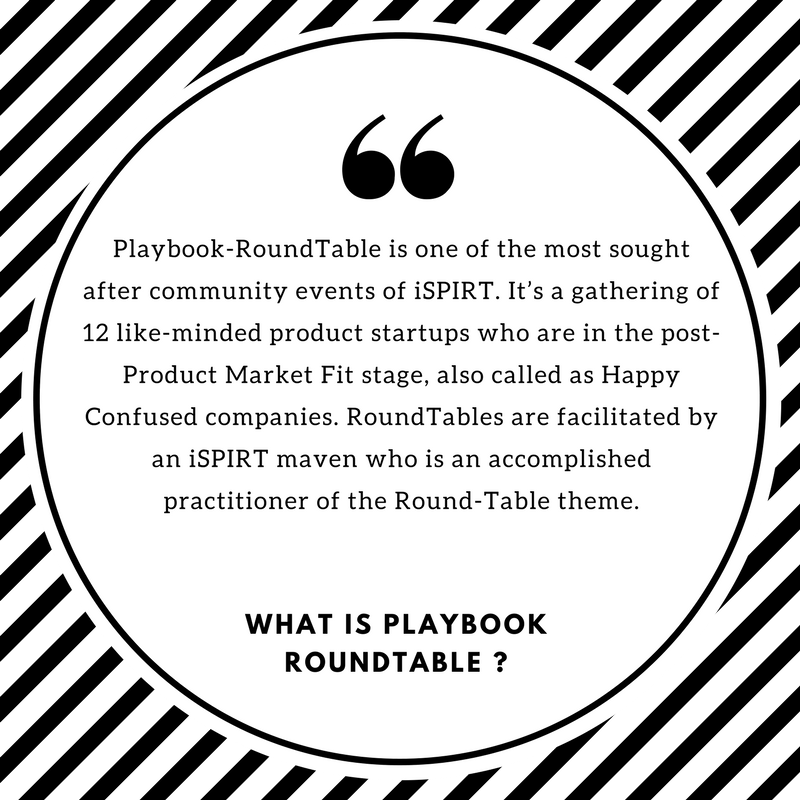
As crisp as that sounds, it took us around 15 Round Tables to distill this elevator pitch, and truly understand our own product-market fit.
This is the story of how it all began, and of the amazing journey, the lessons, the people who made it all possible. For those of you who love visuals more or are pressed for time, there is a photo-story at the end of this post — please feel free to scroll to the end of this post for that.

Inthe early days of iSPIRT, Sharad(iSPIRT) initiated the process of the mentoring program with Ashish Gupta(HelionVC), Aneesh Reddy(Capillary), Vivek Subramaniam(iCreate/Fintellix) in order to put together a mentorship program for product companies. We iterated over 10–12 calls about the format, audience, focus and how things will be run. Once everything was nailed down, Ashish took the lead of curating the first playbook and the facilitator was Shankar Maruwada(EkStep).
You can see the level of planning which went behind the scenes of the first playbook.
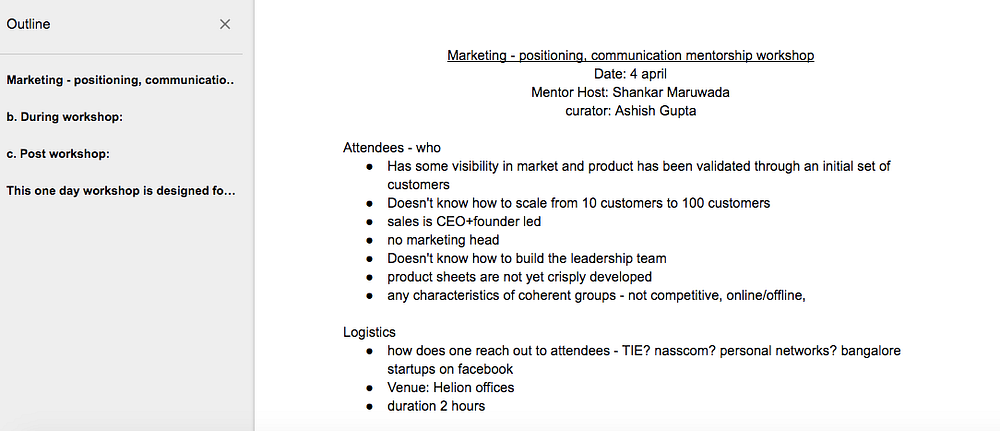
Pallav Nadhani(FusionCharts) & Ambarish Gupta(Knowlarity) were part of the first playbook and added lot of valuable insights and others benefitted from this learnings.

Ashish was a splendid host for the first playbook. I still remember the yummy samosas and kachoris that we got during the break and I still remember Ashish helping his office boy in serving tea to all the participants. I was blown away by the simplicity and the humbleness of Ashish. Thanks to Nikhil Kulkarni(Flipkart) for capturing all learnings in a subtle way.

The next goal was to conduct Playbooks around Product Management & Sales in different cities. I remember Amit Ranjan(then Slideshare) & Amit Somani(then MakeMyTrip) helping us with the Product Management Roundtable in Delhi and Aneesh Reddy(Capillary) helped in curating the Playbook. Ankur Singla(then Akoksha) then did a wonderful piece on Notes on Product Management — insights from Slideshare / MMT / ex-Google PM.
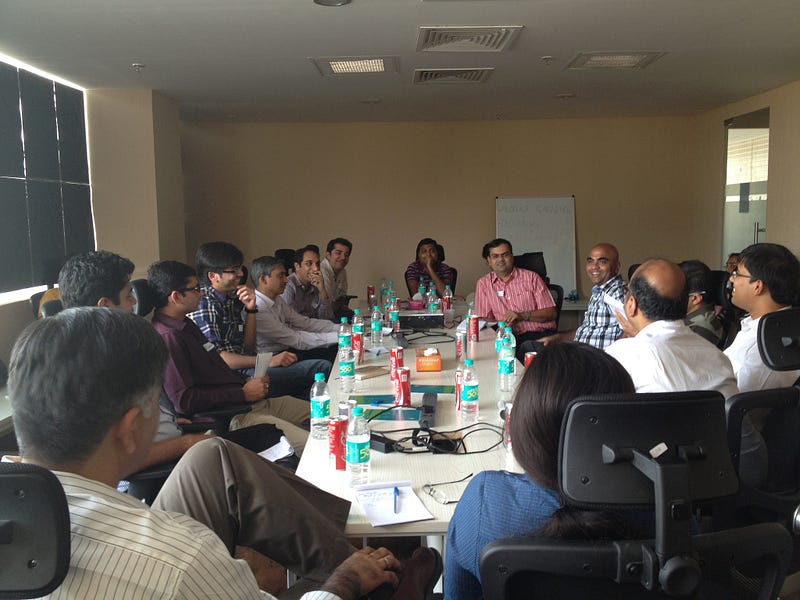
Ashish Gupta also helped in connecting with Samir Palnitkar(ShopSocially)who kicked off the PlaybookRT in Pune. Sandeep Todi(then Emportant)helped with the blog on Challenges in Building a Global Product Software company from India. It was a little challenge initially to get the right audience, but we just got few good people like Mohit Garg(MindTickle) help in inviting few founders for this playbook.
I got to read a wonderful blog post by Sridhar Ranganathan on Products and I did reach out to him to see if he could help us with the Playbooks. He liked the idea and Aneesh did the selling to him. Sridhar travelled to different cities and did the first playbook for us in Chennai & Hyderabad.
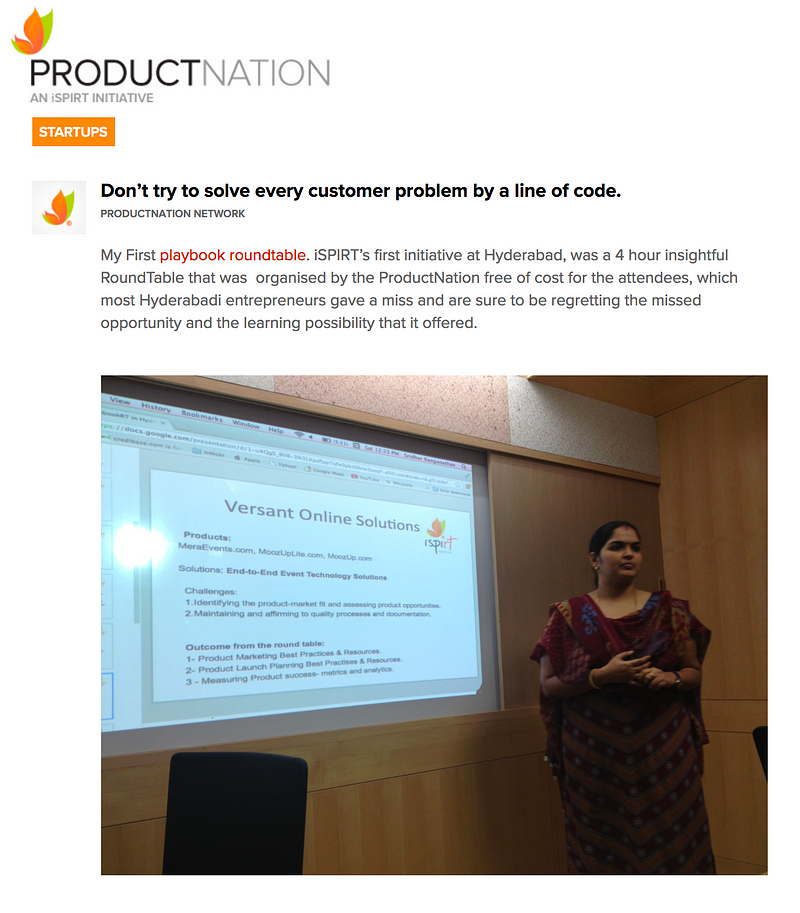
The attendance for the Hyderabad playbook was thin, but the session was very interactive and the 7–8 folks who attended, had a lot to take away from the discussion. Here is what was captured by one of the attendees Don’t try to solve every customer problem by a line of code.
I learnt a lot from Sridhar’s playbook on product management. Vijay Sharma(then Exotel) captured the learnings of the playbook here Product RoundTable Bangalore @ Vizury Office
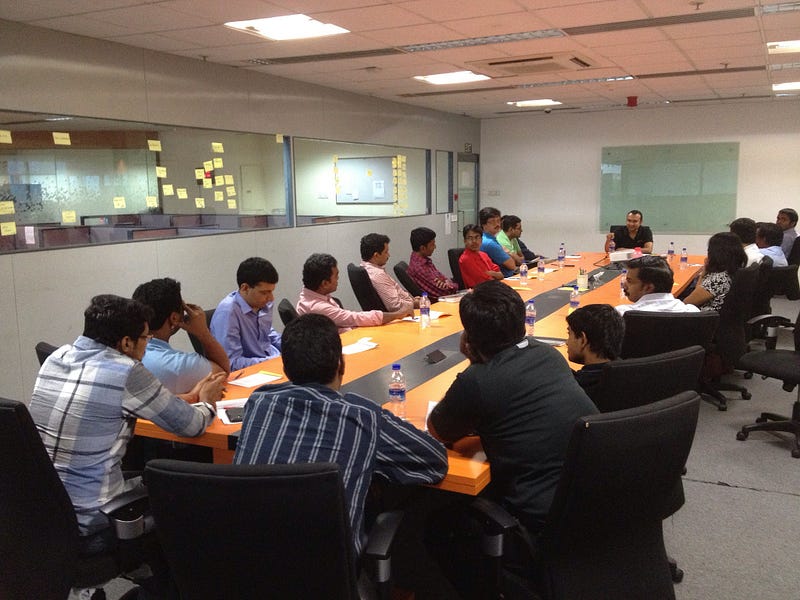
We did a late beginning for Mumbai and thanks to Avlesh(WebEngage) for helping us in starting the movement with Sandeep’s support. Avlesh disappeared in the middle of the playbook and he had lots of documents to sign as it was a saturday… But I remember Sandeep holding the fort till Avlesh came back and shared his learnings of building WebEngage.
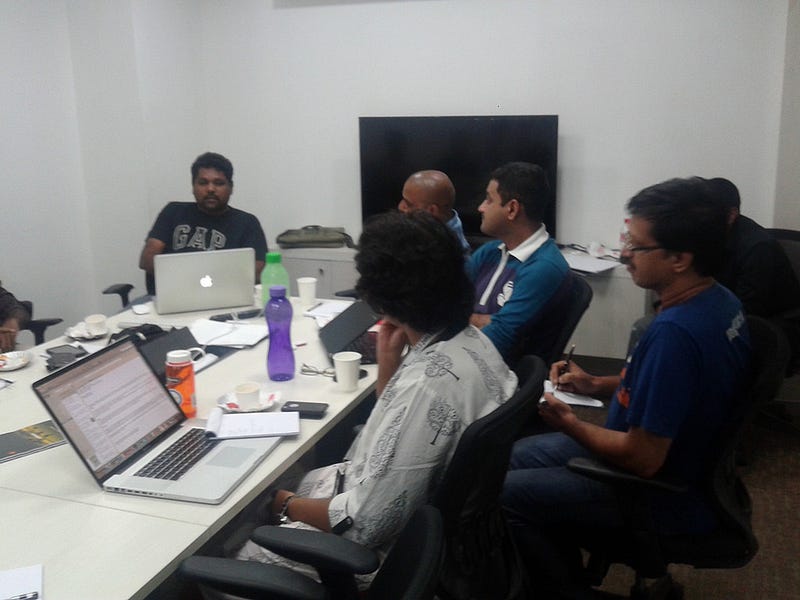

Organizing and hosting a playbook is no small feat. It has taken us a lot of time to put together the following checklist. Feel free to use it if you would like to put together something similar for your community. We have built new initiatives like Cohorts, etc using the same principles.

Curator Checklist
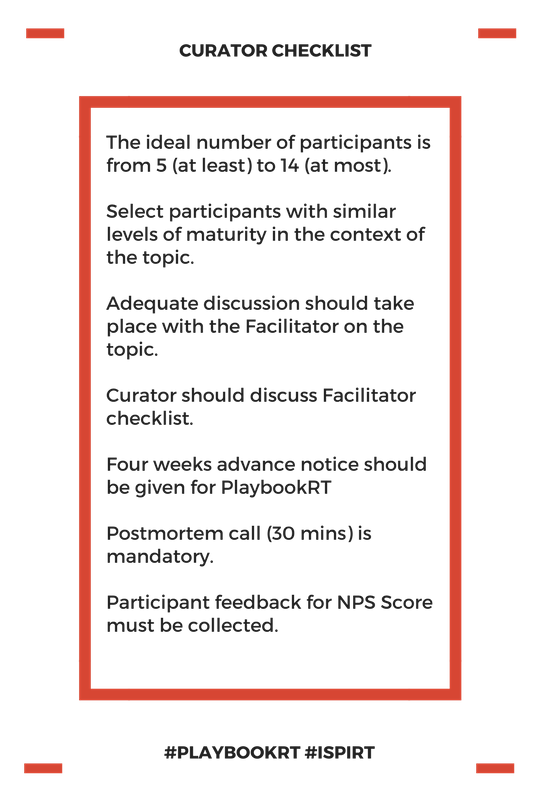
- There cannot be more than 12–14 participants. The sweet spot is 10–12 participants. Minimum number is 5.
- We must select participants with similar levels of maturity in the context of the topic. (Over time we should develop a predicted coherence score and see if that prediction is valid based on post-RT data collection.)
- Adequate discussion should take place with the Facilitator on the topic. It should be sufficiently narrow. It should not be about batting as a whole but about how to play leg-spinners. There would be a Plan B by the Facilitator if the topic ends up being too narrow. It is wiser to err on the side of being too narrow, rather than being too broad.
- It is mandatory to for a first-time Facilitator to attend a PlaybookRT for at least one hour.
- Curator should discuss Facilitator checklist. This discussion should happen before selection of the topic.
- Four weeks advance notice should be given for PlaybookRT if it is not tapping into a pre-curated participant list (e.g. BEX or InTech50). This is to ensure cross-city participation.
- Postmortem call (30 mins) is mandatory. Participant feedback and other learning should be discussed in this call. At the end of the call Curator should assign an overall rating (on a scale of 5) to the PlaybookRT.
- Participant feedback for NPS Score must be collected.
Facilitator Checklist
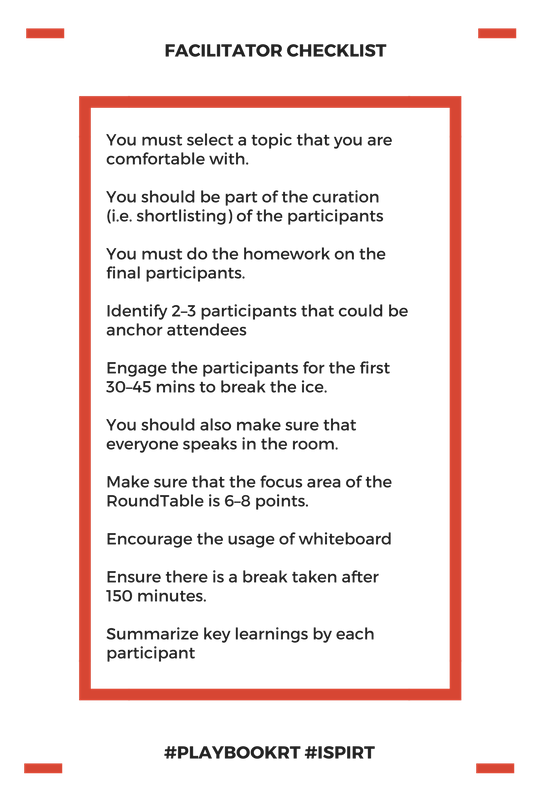
- You must select a topic that you are comfortable with. You must have expert practitioner knowledge about this topic.
- You should reach out to startups to scope out the specific topic areas you’ll cover.
- You should be part of the curation (i.e. shortlisting) of the participants… you must try and get participants at the same level.
- You must do the homework on the final participants. You must learn about the startups by visiting their website. You must also understand the challenges faced and expectations from the PlaybookRT (this information is in the form filled by the participant).
- Identify 2–3 participants that could be anchor attendees — folks who will trigger conversations and also add value to the conversations.
- Engage the participants for the first 30–45 mins to break the ice. You should go beyond introductions — Something on the lines of: We are struggling to do xyz. The goal is to create an atmosphere of trust so that they spell out more details.
- Participants are continuously requested to chime in with their views. You should also make sure that everyone speaks in the room. For instance, Shankar Maruwada asks very specific questions to participants along the way. He is able to do this because he has done homework on each participant beforehand.
- Seating should be such that people can see each other.
- Make sure that the focus area of the RoundTable is 6–8 points. It is difficult for participants to retain more than.
- Encourage the usage of whiteboard with participants. This allows people to change position and brings energy in the room. Peer learning is vitally important. Don’t be a sage on stage.
- Share list of books/videos/tools that participants should use after the RT.
- Ensure there is a break taken after 150 minutes.
- At the end, summarise key learnings by each participant. Everyone speaks for at least 2–3 mins.
My job has been very simple, just keep hunting for the Curators & Facilitators and allow them to make the magic happen 🙂

- 0–100 customers! How fast can your SaaS startup accelerate? By Ankit Oberoi
- Setting up Inside Sales to sell SaaS into US — Learning’s from iSPIRT #PlaybookRT by Suresh Sambandam
- Design thinking Playbook Roundtable by Deepa Bachu
- Mobile Product & Growth Hacking RoundTable #playbookRT by @amitsomani & @VishalAnand
- The best things are simple. Is your messaging there yet? : from #PlaybookRT by Shankar Maruwada
- How to Structure Sales and Marketing in a SaaS Business by Girish Mathrubootham
- Nuts & Bolts of Marketing & Selling in US for First Timers: A crash course playbook!! By Suresh Sambandam
- 40th #PlayBookRT in NCR on “Break the Barriers of Selling” by Deepak Prakash
- Understanding Software Sales from the Tally Experience
- Rediscovering America — The SaaS way ! by Samir Palnitkar
- Product Management Roundtable For Startups by iSPIRT In Pune. #PlaybookRT by Amit Somani & Rahul Kulkarni
- 22nd #PlaybookRT — Solving a customer’s problem in a way your competitor is not doing, is the most memorable thing for your customer or partner by Pallav Nadhani.
- 21st #PlaybookRT — 13 Sales Mantras for Product Selling in India — Part 1 by Aneesh Reddy
- India as a Product Nation is in good hands — Insights from the Lean Sales Roundtable by Pallav Nadhani, Paras Chopra, Varun Shoor
- Don’t Build Something Unless Someone Is Willing To Pay For It & Asks For It Twice! By Sridhar Ranganathan
- Product Management for Startups and Understanding Growth #Playbookrt52 by Amit Ranjan
Access the complete list of PlaybookRoundtables here. Some learnings from the Playbook Roundtables have been captured here by my friend Rajan(then Intuit). 90% of the Playbooks did get a NPS Score of 80+. Special thanks to Rajan who kept pushing for this 🙂
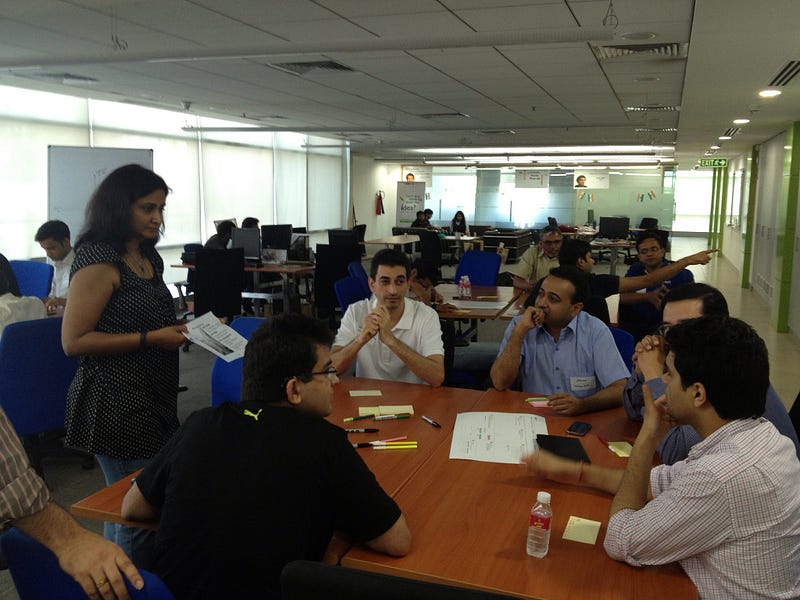
From the 50th PlaybookRT
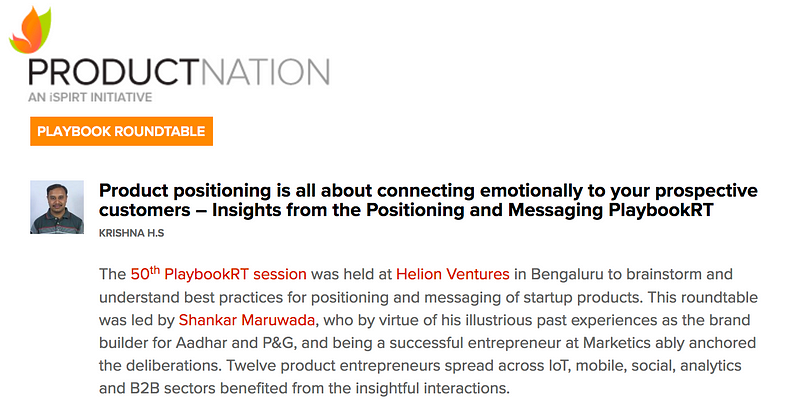
Shankar helped in putting together the 50th Playbook and it was good to get some folks who had attended the first playbook joining this one.
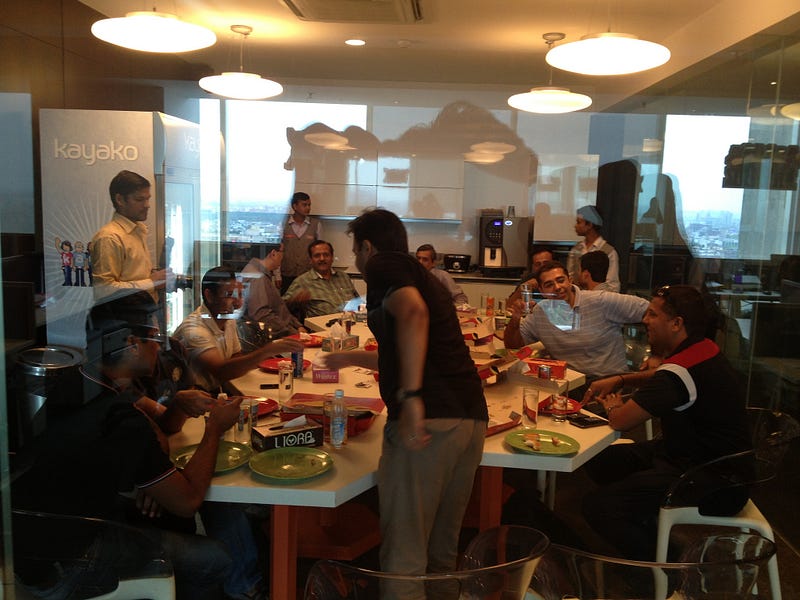

Mavens are trusted experts who pass knowledge to other founders in a pay-forward model in small intimate learning sessions.
Some of our Mavens are
Aneesh Reddy, Pallav Nadhani, Amit Somani, Amit Ranjan, Avlesh Singh, Deepa Bachu, Deepak Prakash, Girish Mathrubootham, Niraj Ranjan, Jay Pullur, Paras Chopra, Pravin Jadhav, Rushabh Mehta, Samir Palnitkar, Sanjay Shah, Shankar Maruwada, Suresh Sambandam.
Some of them who are not mavens but have helped us with few roundtables are:
Vivek Subramanyam, Sudheer Koneru, Ambarish Gupta, Phanindra Sama, Abhishek Sinha, Ashwin Ramesh, Shashank ND, Shivakumar Ganesan(Shivku), Krish Subramaniam, Ankit Oberoi, Arpit Rai, Varun Shoor, Dhruv Shenoy, Manav Garg, Naveen Gupta, Rajiv Srivatsa, Sampad Swain, Kailash Katkar.
A big shout-out to Suresh Sambandam for doing the maximum number of playbooks 🙂
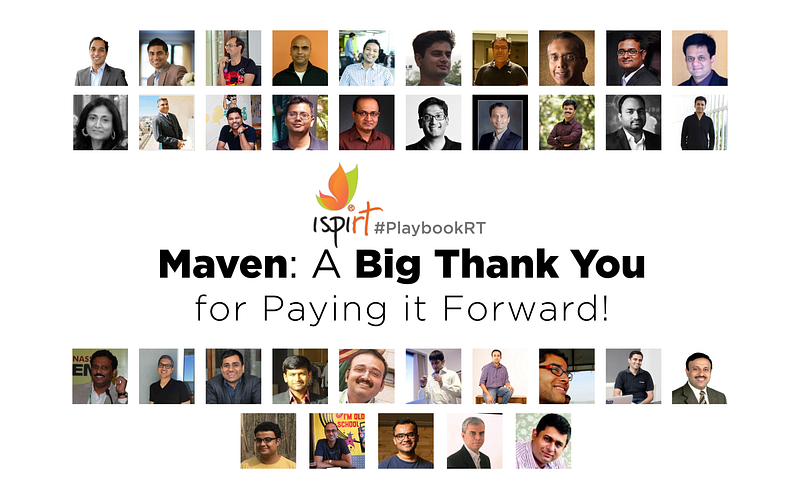
Special thanks to Niraj Ranjan Rout(Hiver) & Rushabh Mehta(ERPnext) for introducing the new format i.e the Tear Down sessions and helping early stage(pre-product market fit) companies on helping them find their product market fit.
All the Maven’s have signed the below code of ethics:
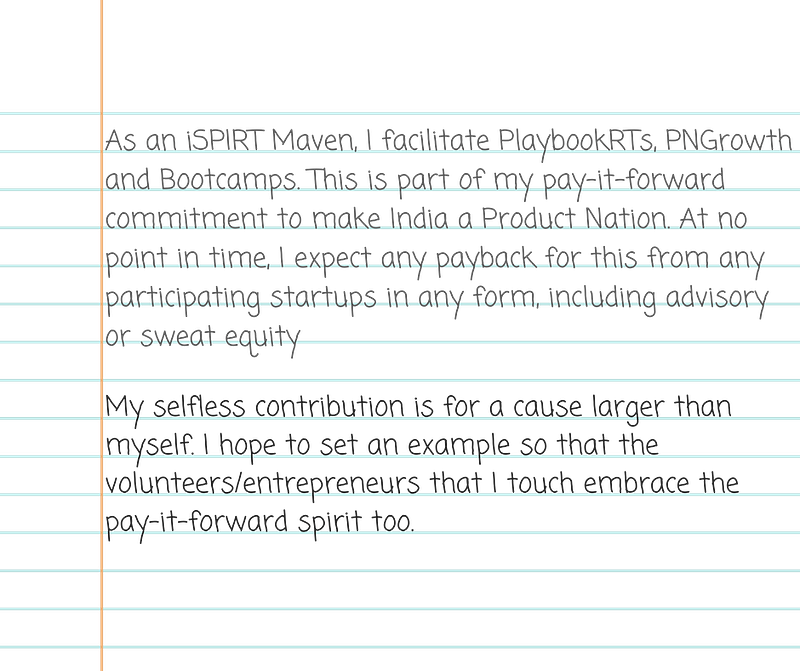
Our team of Dedicated & Committed Volunteers who made this happen in each city
Thanks to you who make time in your incredibly busy lives to make these sessions happen.
- Rajat Harlalka in Delhi
- Sandeep Todi & Sudarshan Ravi in Mumbai
- Siddharth Deshmukh, Abhijeet Mhetre, Aditya Bhelande in Pune
- Nikhil Kulkarni, Titash Neogi, Natwar Maheshwari, Gokul Bose, Thiyagarajan M(Rajan), Amarpreet Kalkat in Bangalore
- Chaitanya C, Laxman Papineni in Hyderabad
- Ashwin Ramaswamy, Kingston David in Chennai
- Ankit Dudhewala in Ahmedabad.
Companies who hosted the Playbook Roundtables and also hosted some awesome snacks/lunch/dinner 🙂
- Delhi-NCR — Eko, Investopad, Posist, Wingify, AdPushup, Kayako, Knowlarity.
- Bangalore — Exotel, Vizury, iCreate(Fintellix), Capillary, Instamojo, Hotelogix, Helion, Accel, DeckApp, SignEasy, Belong, HiverHq, Practo, RazorPay, Synup, UrbanLadder, 24/7 Customer, Elitmus, Srishti Software.
- Ahmedabad — IIM
- Pune — QuickHeal, HelpShift, Pubmatic, Sokrati, TouchMagix, K-Point.
- Mumbai — WebEngage, FreeCharge, WishBerry, LightBox, BrowserStack.
- Chennai — OrangeScape, Freshdesk, Chargebee, Zarget.
- Hyderabad — Ozonetel, Pramati, Zenoti.
Many volunteers who have helped in writing blogs for and about the sessions and also help in editing some of my blogs… especially Sairam Krishnan & Kingston David.
I am terribly sorry if I have missed out someone here! I know you will be modest but please do let me know so that I can add your name here. In highlighting your efforts, we motivate others in our quest to make India, a ProductNation…
ProductNation Founders Tribe
There are around 1000+ Founders who have leveraged the playbooks and the list can be accessed here.

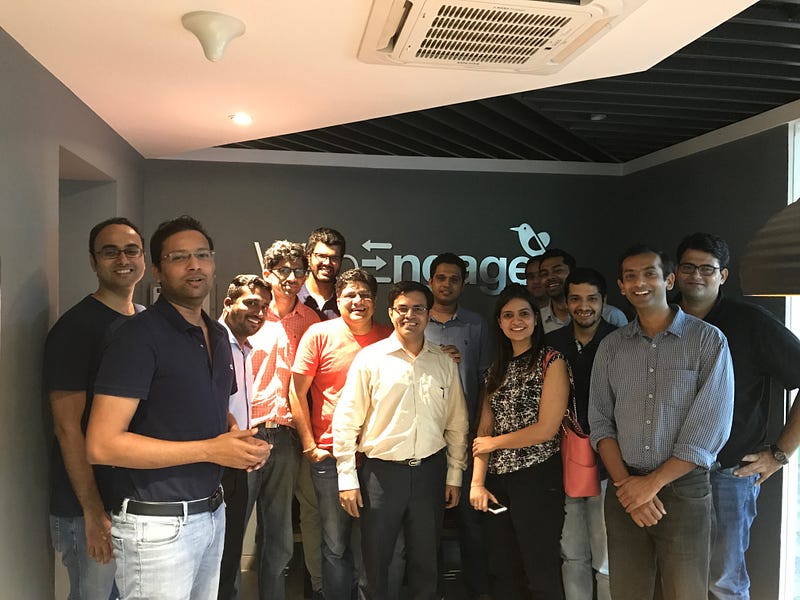

Iam really glad that I will participating at the 100th Playbook Roundtable in Chennai on “Inbound Marketing — Workshop for DIY Global SaaS Startups”. This would be led by Krish of ChargeBee & Suresh of KiSSFlow.
This marks an incredible milestone since our journey began in 2013, and demonstrates the increasing demand for our playbooks every year.
Circling back to my cricket story at the start of this write-up, we all start with an outrageous dream. It is definitely good to dream big but when there is a bigger calling, we should yield to it!
I am so very proud that we’ve reached this milestone. Thank you for your support, and I look forward to celebrating more milestones together in the future.
Thanks to Kingston David for editing this & Titash Neogi for making this look good 🙂


There are hundreds of big and small moments that have made up this journey so far — it is impossible to capture them all here, but I am sharing some of these moments via this photo story — I hope to give you a flavour of the energy and spirit of what made us reach 100!
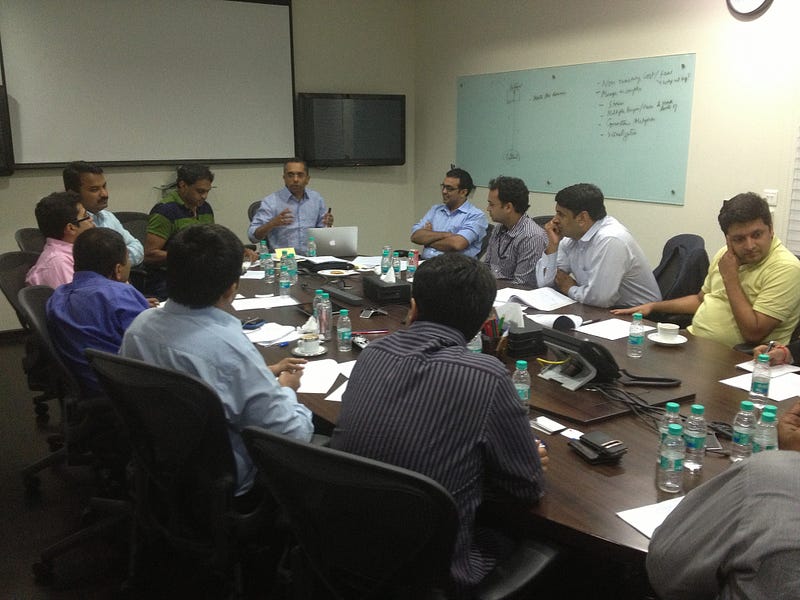

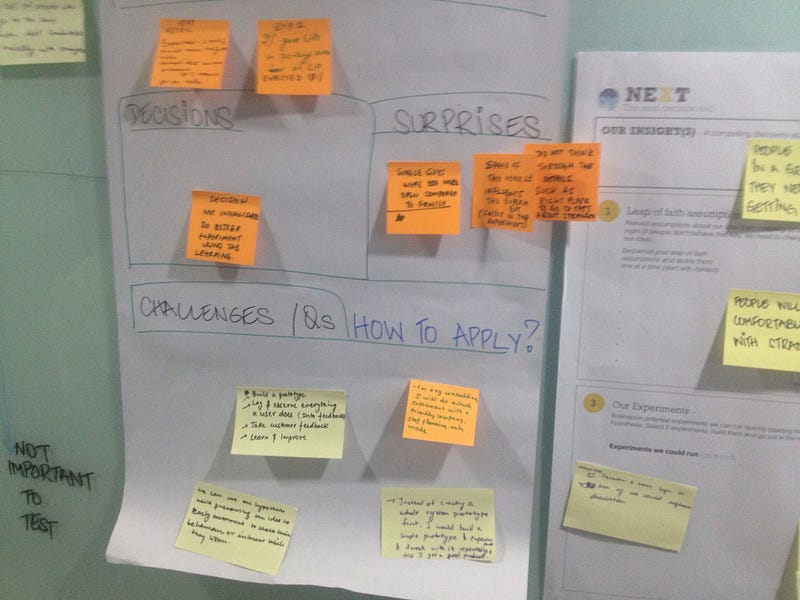


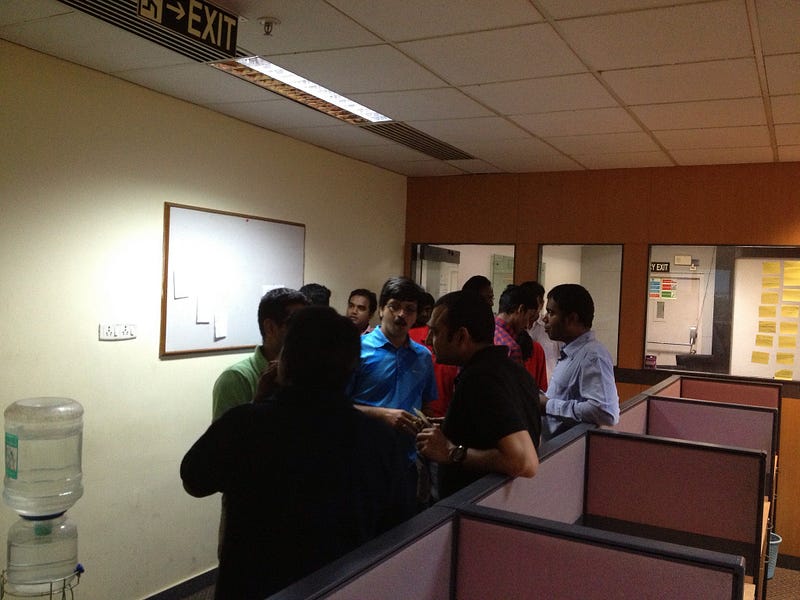
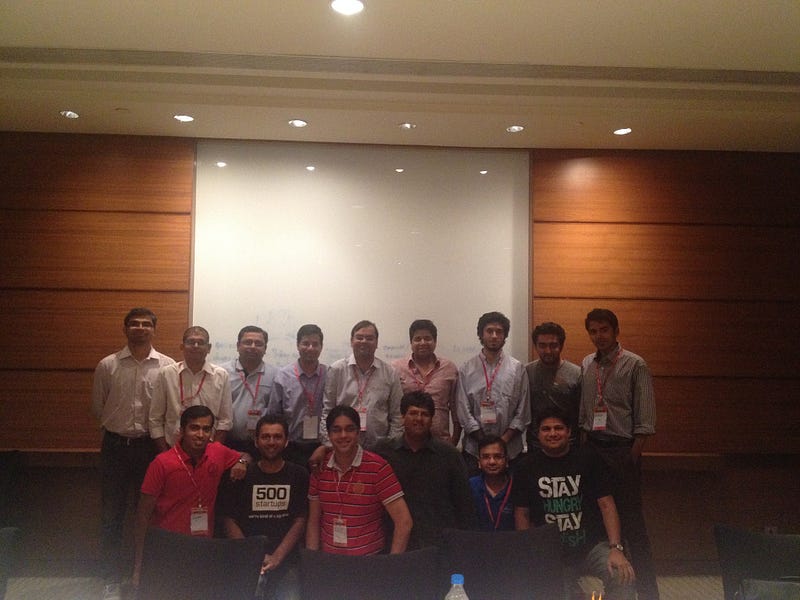
See more photographs on the FlickR album and few photos here
Understanding Your Customers And Building For Them – #99PlaybookRT
Building great products requires us to understand customer needs and its nuances, are more often than not, counter-intuitive to our assumptions. The Design Thinking Roundtable session by Deepa Bachu helped us identify methods to bridge this gap between building great products and understanding customer need. I was lucky enough to be part of the small group of product managers, designers, and fellow entrepreneurs to have an engaging discussion onimportance of design as an innovation strategy. How well do you know your customer?
How well do you know your customer?
Deepa’s opening question “Do you know your customer?” probably got all of us thinking on do we really know our customer. Personally, I somewhat know my customer. Just for that veryreason I am sitting at my client’s front office to fulfill the basic requirement: that of understanding my customer better. Working with Enterprise businesses requires us to learn and appreciate that we have 2 types of customers: 1> Management 2> the Actual End-user. We build our assumptions from our conversations with the management team who are the decision makers, but it’s the end-user that matters. The end-user, who is the employee should stand to benefit equally or probably more than the management, for our product to succeed. Every designaspect, needs to be geared to make the daily user happy. Understand your customers
Understand your customers
After knowing who your customer is, the ascent for a better product begins with sitting down with the end user in an amicable environment to learn about their challenges and their day to day experience. Deepa pointed out the importance of empathy, active listening and observation to help capture the end-user’s experience. Her role play exercise with one of the participants around the difference in the approach on asking open-ended questions while actively listening and observing delivered a completely different set of answers, in comparison to when as an interviewer she was asking closed ended questions and was not actively listening. In short, let your customer speak & take notes!!
Participants in the middle of the interview role play exercise
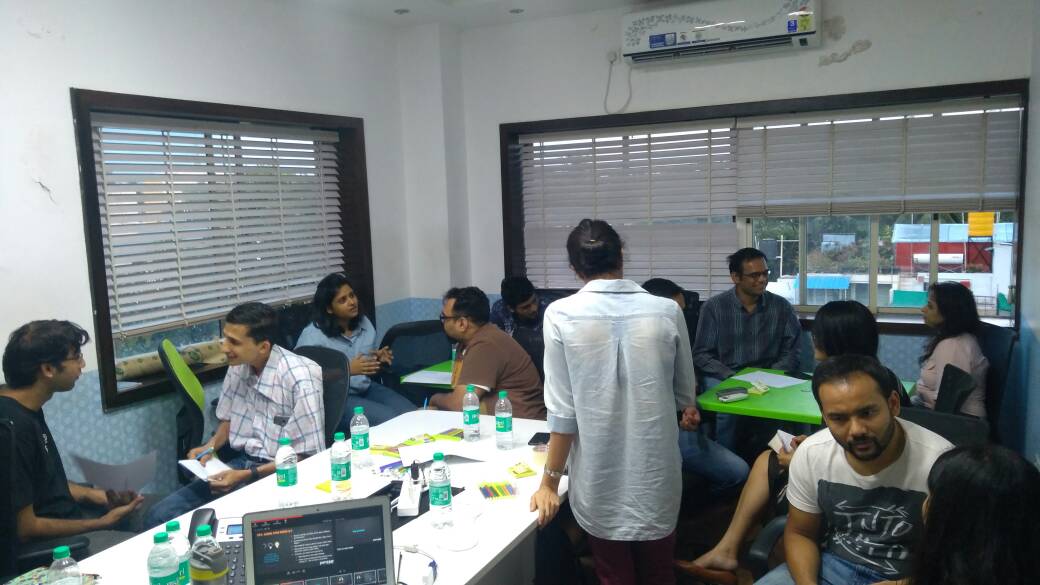
Developing Insights
Remember that the customer is only explaining their challenges or sharing their activities. Value addition to our product comes with inferring from these observations to identify insights. To find that hidden customer need, we will need to introduce adequate structure to the information collected from the customer / end-user. Some of the tools for us to use are:
- Empathy Maps to record our observations, which helps us split the talk and action of the end user that we can use to interpret the observations
- Ecosystem Maps help us understand the customer’s environment and his / her ecosystem. A map to tell us the sequence of events that are leading upto our solution or after the solution.
- Problem Statement helps us see the customer’sview point and their emotionalconnect to the problem. From a product point of view, we can turn a poor customer experience into customer delight by evoking the right positive emotion after using our product. Mind you, these folks are your product advocates.

Customer Benefit
The core of design principles is not nailing your UI/UX, it is matching your customer need, the problem they are facing in the environment they are using / will use our product. Only when the experience matches this customer need will we really see true customer benefit. Value addition of this benefit requires the need to collect the right metrics to understand if we genuinely made a difference instead of vanity metrics like just increased downloads / users.
By understanding our genuine impact, we can course-correct our product with continuous improvement coupled with rapid prototyping to help us slowly move towards our product goals and vision.
What’s the one thing participants will do differently after the #RoundTable?
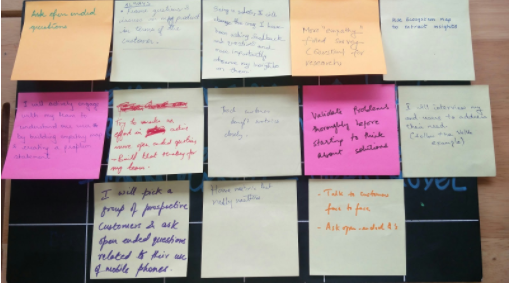
Overall a great learning experience thanks to Pensaar and iSPIRT for setting up this session.
By Rohit Krishnam, Co-founder of Lima Payments.
Editor’s Note: This #RoundTable happened to the 99th one and there was a small celebration on this occasion. It’s been a great journey so far and we’d like to thank all the participants, facilitators and volunteers who made this possible. Here’s to making India a Product Nation.
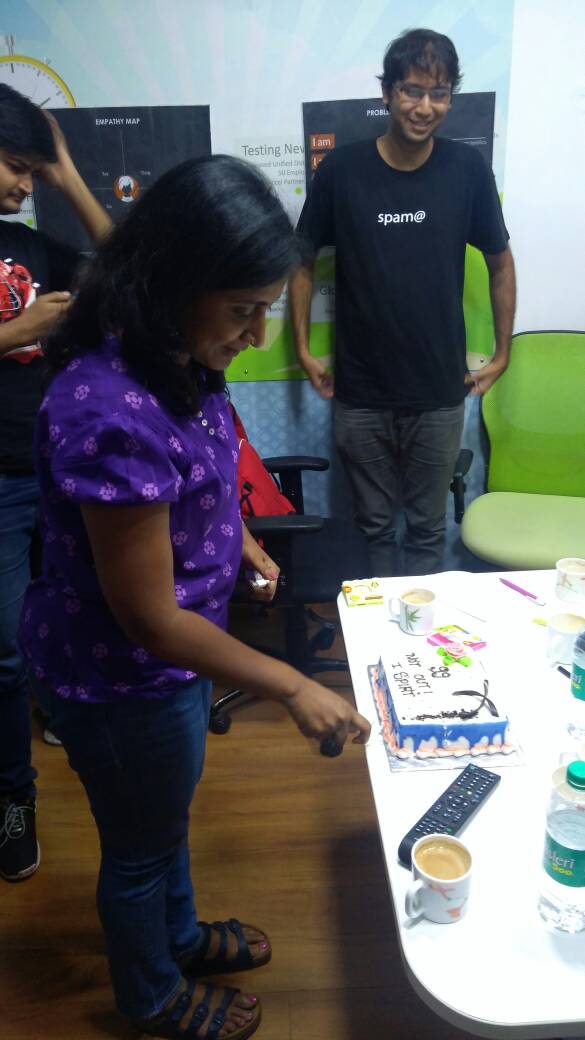
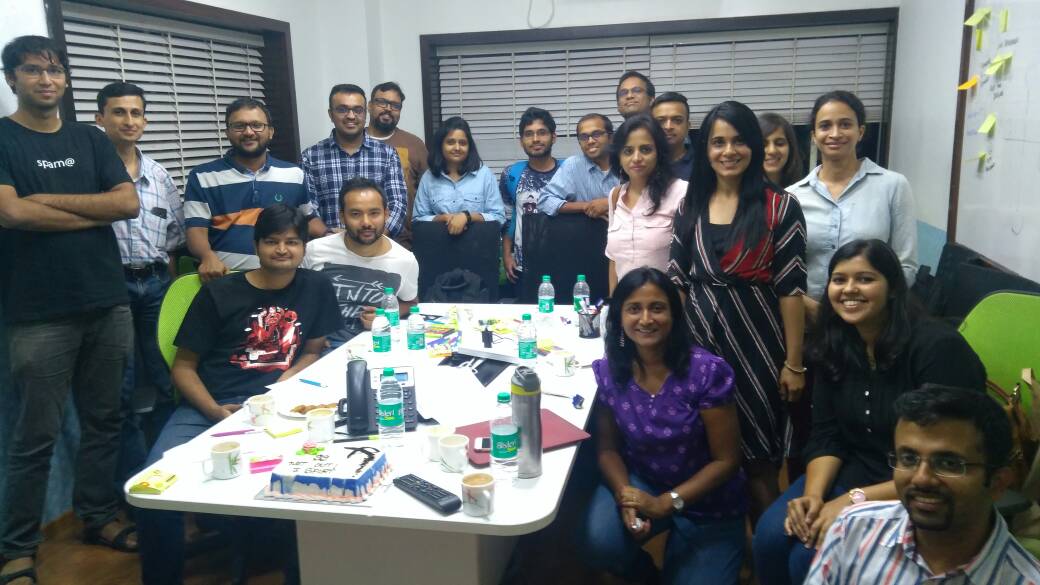
Are you having fun in what you do? #PlaybookRT
Michael Jordan once remarked: “I’ve missed more than 9,000 shots in my career. I’ve lost almost 300 games. 26 times I’ve been trusted to take the game’s winning shot and missed. I’ve failed over and over and over again in my life and that’s why I succeed.”
Ask any entrepreneur, and they will say, well, this is the story of my life. Owning a business is one of the most cognitively challenging jobs. To move from a stable job with a steady income to one where uncertainty is the flavor of the day every day takes courage, competence and confidence. Most of all, it requires an emotional tolerance strong enough to deal with the pressures of change and unpredictability, not to mention the mental fortitude to navigate through it.
As iSPIRT approaches its 100th Playbook Roundtable, Avinash conceived the idea of a completely different roundtable theme. One that focused not on strategies and tactics that a founder could apply to his product but one that focused more on the tremendous evolution that an entrepreneur goes through in his or her journey. And who better than Abhishek Sinha of Eko to facilitate such a roundtable.
The playbook was held at Eko’s office on 3rd June 2017 with a select set of entrepreneurs in the Delhi NCR region.
Taking a leaf from Jeff Bezos’s playbook, Abhishek drafted a 6 pager that covered important phases in his entrepreneurial journey, and all the participants spent the first 30 mins going through it.
In this 6 pager, Abhishek shared real life stories all through his journey of 6d and Eko. These stories touched upon how he became desperate and did more of the same. How he understood for the very first time that it is critical to think different. How he attempted at thinking big and audacious. Why being young and with it being foolish and naïve helped. Once one has started on a big goal why it is critical to developing the understanding of the landscape especially regulations. How he learned the importance of execution, scaling and making money. The mistakes he made when Sequoia and Khosla wanted to write cheques and he couldn’t close the deal.
More importantly the lows in his personal life and how he sought help to get things back on track. How he has personally exhausted all options to lose and hence winning is the only option. Today, as a battle-hardened entrepreneur, why he has the conviction of success.
These thoughts set up the tone for an interesting set of candid discussions and expressions over the next few hours. I have captured some of them below:
Enjoy your journey
Most of us started on the entrepreneurship journey with the idea to create something cool or do something fun. It was never about creating a billion dollar business. There was a lot of pureness to this thought as we went about solving one problem at a time, and having fun. But slowly we stop enjoying ourselves. We stop thinking differently and start doing the same thing again, and again. This brings in predictability but stops us from experimenting different things.
So when you are questioning your journey and your growth (success or lack their off), just remember you are where you are supposed to be. It will work out fine, just trust in your journey. Sit back and relax and enjoy the ride. You will be surprised where it takes you.
Once you get to the top of the mountain you may come to miss the fields below. So take the climb one step at a time and enjoy the journey, entrepreneurs.
Destiny
Abhishek reflected on near-death experiences in his business and how he managed to get over it. He hasn’t been able to put my head around why a certain deal fails and why one succeeds. Ambarish from Knowlarity too chimed with a similar thought where atleast one or 5 occassions, something happened that kept him and his business going. If one simply applies theories of probability to these random events, the result becomes even more inexplicable.
This has driven Abhishek towards the realm of spirituality and over a time trust in a higher energy which has taken care of him. He has become a strong believer in destiny and a higher power, and that if we pursue our dreams the doors will open up.
At the risk of being cheeky, I couldn’t help but share this SRK dialogue.
Believing in destiny though is not about sitting back, and letting whatever is happening to happen.
Create a Cause or Purpose that People can relate to
Abhishek mentioned how he takes inspiration from religious organizations that create a cause that people can relate to, and inspires them to work towards its goals. Mark Zuckerberg in his recent commencement speech at Harvard also touched upon this, where he mentioned that when President Kennedy was visiting NASA space center, he asked a janitor what was he doing, to which he replied “I am putting a man on the moon Mr. President.”
A sense of purpose truly comes from within, and you can’t find meaning with a company that doesn’t share your values. So one of the simplest ways to cultivate a meaningful workplace is to stack your team with people who share the passions of your company. When everyone is aligned as a part of a bigger movement — that’s when the true meaning behind your work (and your company) shines through.
Ambarish shared how he ensures that all candidates, interns and vendors in his company are interviewed personally by him. This does take away a sizeable amount of him time, but it helps in multiple ways:
- It keeps his team on the check as they know all vendors and candidates have to get past Ambarish
- In his interview, Ambarish dissuades candidates to join by spelling out all the challenges of working at Knowlarity. This ensures they don’t just actually hire but let those people who in who really want to join Knowlarity
Driving ownership in teams and individuals
Entrepreneurs are problem solvers and product people, and are able to spot patterns & problems in the current scheme of things, and the relevant solutions very easily. And we immediately get our teams to work on the solution. This is a bottom up approach. You instruct an employee to perform a task or even accomplish a goal. But in effect you still own that task or goal. You tell the employee what you want, you define success and you create metrics to measure that success. That’s accountability. The employee takes responsibility for getting done what you want.
However a top down approach requires entrepreneur to only mention the problem to the teams and outline the contours, and let them come with the solution. This requires patience, and as more often than not, the solution will be staring right at your face while team members will go though their own curve before they discover it. But once the team members do come up with the solution, there is more ownership as this is now their baby.
Ownership happens when an employee comes forward and says, “I’m going to make this happen. Here’s what I will do. Here’s what I will accomplish. And here’s how I will measure progress.”
If you only have one or two employees and you love to micromanage, you can get by with hiring people you will simply hold accountable.
But if you’re truly trying to scale your business for growth, micromanagement soon fails. There is simply no way a chief can be involved in every task, process and decision.
If you foster a culture of ownership, you don’t need to be involved in every detail. You can focus your attention elsewhere, secure in the knowledge that owners will always come to you when they have problems or need help.
Be Different and Not Just Better
It’s not about doing more or better, it’s about doing different. If you can create that which is new and different you stand a greater chance of success. You can find white spaces that you can fill in.
When you break rules, you experience something unique. Ensure you savor this uniqueness even if your ideas bomb because these unique and different efforts will create experiences that themselves are unique.
Create Crisis In Your Mind
An entrepreneur often needs to play mental games with himself or herself. These games allow you to challenge yourself and create a crisis in your mind that pushes you to think creatively and innovate. If fear of the unknown has you tied down, try this: after you find yourself posing the “what if?” question to yourself, answer it. By doing so you bring that unknown fear into reality and make it more tangible and certain. With certainty comes clarity and with clarity comes opportunity to crush all challenges.
Remove Safety Nets and Bring Focus
Having safety nets or diversions lead to entrepreneurs loosing focus. It sometimes become imperative to remove these safety nets. When you have safety nets, you are not all in. It makes you timid to jump in with both feet. But when you remove all these safety nets, you have only one choice: take the leap.
Having your back against the wall you are forced to go all in, forced to make it work, forced to believe in yourself.
The session culminated with Abhishek sharing how he is taking inspiration from the Android model and smartphones that creates an unbundled experience for consumers. Feature phone could do (i) calling (ii) messaging (iii) entertainment / games (iv) value added services like calendar, alarm, notes etc. Though all these are fairly tightly bundled and hence customer couldn’t exercise choice – take it or leave it. Smartphone is an unbundled architecture. It offers the same four functionalities though as its architecture is completely unbundled and open – it empowers the customer to make the choice basis their transaction scenario / context and cost. A similar framework could be applied to several industries to create unique products and solutions.
As the session ended, one could sense how Abhishek had been socialised to the highs and lows of business life. The mental game of entrepreneurship often feels like Snakes and Ladders. There were days for Abhishek when he just wanted to run away, where he felt as if he was in freefall and plummeting to the ground without a parachute. But, looking back, those are the moments that defined him. He has accepted – sometimes with a lot of delay and a good fight – that he was the architect of the bad situations and he accepted full responsibility for them. That is how he bought his freedom.
It’s only by acknowledging your failures that you can build on your successes.
Guest Post by Rajat Harlalka, Volunteer for iSPIRT
0 – 100 customers! How fast can your SaaS startup accelerate?
The toughest challenge in your startup journey is getting to the milestone of first 100 customers. iSPIRT’s 97th PlayBook RoundTable, ‘Zero to One’ was held last Saturday in the hot and humid city of Chennai.
Ankit Oberoi from AdPushUp moderated the RoundTable which was attended by 13 other startup founders eager to know how to crack this. The PlayBook didn’t have formal presentations but rather involved everyone into an engaging conversation that was both informal as well as informative.
First things first, as early stage SaaS startups, “Kneel down and build your product well, when bootstrapped” was Ankit’s advice.
Identifying Target Customers
Emphasis was made on identifying your target customers to help you build the right inbound and outbound strategies. Ankit mentioned that a good way to find your target customer type is to look at your top ten customers. Few entrepreneurs looking to generate quick revenue might tend to drift towards a service model.

Arvind Parthiban, CEO of Zarget had an insight on this trend — “Going the service way will work only if one can scale up right and maintain profitability in the longer run”.
Inbound Marketing Tactics
A majority of the discussion was about inbound procedures. 3 simple things should make up your Content Marketing strategy –
- Identifying your target persona
- Creating quality content
- Setting up distribution channels
Just creating content will not cut it! You need to market it right to do justice to its quality.
Though it is a painfully long process, bootstrapped startups have the luxury of time and they should invest in building on content strategies around long tail keywords. Much emphasis was given as to why content should be created for personas. An example that was pointed out for this was Groove’s blog where the focus is exclusively on founders.
It is right for early-stage startups to focus on generating traffic through content but the real focus should be on giving value to the readers. Conversions can happen even later and not necessarily while reading your content. Growing a subscription list through your blog is not only a no-brainer, but a must have item in your growth stack .
Ankit stressed on how Neil Patel talks about why you need to urge your readers to subscribe right from the start. When you have a subscribers list, you can nurture them to share your content and build a bigger subscribers list which will ultimately increase your brand value and improve your customer base. Initial days of your startup journey are when you can do such things that take time to scale.

Intent Defines Inbound
Categorize your efforts based on intent when you are going all out on inbound marketing. Content writing has to be segregated widely into two types –
- Buyer Intent
- Value Intent
Buyer intent content are the ones written with the focus on ranking higher on search engines. These should have focus on keywords and the main objective of these content pieces are to sell your product.
Value intent is when you become a Thought Leader of the industry you are in. Helping your customer persona should be the name of the game when you generate such content. At times, you don’t even have to put a link back to your product when you write such content. Educative long form content with simple writing works best.
Just like content writing, content distribution too has to be categorized based on intent.
- SEO intent — You share the article/blog with search engine ranking in mind
- Sharing intent — You find avenues where people are bound to share the post more
- Distribution intent — Sharing in one place that sets off a chain of shares
Be spot on with your content!
Creating a content calendar is a must! Knowledge sharing on this topic pointed out that the calendar should be finalized, ideally, in the first few days of the month. Decide on buyer intent topics with the help of keyword planners. Thought leader articles can be written with the help of community platforms — find answers for the most-asked questions. Quora is a gold mine to search for blog ideas.
The consensus from the more experienced entrepreneurs at the RoundTable was that content has to be tested too. The headline is the most important bit of your article/blog. Ankit spoke about how 75% of your readers don’t actually read your content but rather scan for information. He shared a personal insight on how just a headline change helped AdPushUp make an article go viral overnight! Check out this article here.
As much as headlines, the first few lines matter too! In fact, most people who share an article actually read the intro and then skim through the article. Sharing happens not because people read it fully but because they feel it is relatable to something they would read and want to express to their circles about the type of content they would read. Your formatting should be spot on to help them digest your post in just a few seconds!
Headlines need to be tested extensively. Vengat from Klenty stressed on how testing one variable at a time is imperative for success. Ankit talked about how he narrows it down from a couple dozen headlines for their blogs. A/B test between the best ones to ensure you get the best variation.
Types of articles to try…
The Zero to One #PlayBookRT stressed on a few interesting article types startups should try –
- Summarizing Comprehensive Blogs — Found something useful? Write a brief, original summary of the blog. This will rank organically. Ensure author credits are given.
- Roundups — Take a pick of useful tips, quotes, tools etc., and do a roundup. Reach out to the people/products/companies you mentioned and they will share it to their followers
- Skyscraper Technique — Find an awesome content and piggyback on it. Find linkable assets, make it better by adding in your thoughts or collating ideas. Reach out to the authors of the post and share it on social media.
While on the topic of Content Marketing, the topic of paid promotions came into play and it was agreed upon that paid promotion for articles should be done with the intent only to hit a critical mass. With paid promotions, readership is not improved but only the views are artificially increased. A good insight from one of the attendees was to try and push notifications about blogs through live chat platforms like Intercom.

Hiring your inbound team
There are two types of talent you need on your inbound team for achieving success in your content marketing endeavours. The hustlers & the experts. Hustlers are those who understand the market and the distribution channels while the experts should be the ones strong in content.
AIESEC is one hiring venue that you should consider for smart and affordable talent.
You need to break down your web analytics — group traffic sources and optimize for each and every source. Ankit explained how Google not only ranks posts but also pulls down posts with the help of Ryan Fishkin’s social experiment. He urged people to open a top ranked post and immediately go back to the search results page. The search engine bots picked this up and realized people no longer find the post valuable and dropped it by one position!
We live in a smart world! And to outsmart Search Engines, you need smarter content tactics.
Quick look at a few other learnings
- Arvind and Ankit then shared their experiences with events generating brand value and how that indirectly helps your inbound conversions.
- PR is yet another way of getting social approval. It reduces sales cycle as well as helps with search engine rankings.
- Vengat shared his learnings from Prodpad’s gamification for trial users that kept urging for additional actions for trial extension. This would inevitably lead to more activation.
- There was a brief session on PPC campaign optimization and how Google’s Quality Score is important
Out-take on Outbound
Ankit stressed on the fact that if a startup concentrates well on inbound tactics and is all set for the long run, outbound becomes considerably easier. Most US companies go all out on inbound tactics. Being in India, we have the luxury to work on outbound marketing at relatively cheap costs.
Tools like BuiltWith, Datanyze, SimilarWeb are in this space. The problem to be addressed would be scaling the process without expanding the existing team. As you reach out to more and more people, the data bulk can be huge to handle if you don’t automate/semi-automate the process.
An entrepreneur’s journey is one to be cherished and the initial acceleration from 0–100 customers is enjoyable though dotted with challenges. The 97th Product Nation PlayBook RoundTable turned out to be a learning experience for everyone who attended and hope this article threw light on what was discussed to those who weren’t lucky enough to be part of it.
Never miss an iSPIRT event again — stay tuned to this page for updates on upcoming Product Nation events. Guest blog post by Kingston David, Zarget
Are you a Baba Entrepreneur? 98th #PlaybookRT
1) Destiny is a Child
2) Create a Crisis on purpose
3) Unbundling of Payments in FinTech
4) Recruiting – Interview the Intern | Work-Life Balance
5) CoFounders
6) Baba, Are you?
Time to decode the ‘Social’ in ‘Social Commerce’
“If I had to guess, Social Commerce is the next area to really blow up” – Mark Zuckerberg
‘Social Commerce’ or more simply ‘Social Payments’ has been a relatively new concept to come up in the last few years. And in most cases, it remained like the early days of big data – easier to toss around but not presenting a clear picture. I believe the vagueness gets accentuated by the fact of the word ‘Social’ being a part of it. This is what leads a whole set of audience out there, to think that just latching on to or simply appending a ‘pay’ option inside a social network makes up for the concept. Nothing could be further from the truth. The true meaning of the word ‘Social’ in ‘Social Commerce’ is actually the full context of your real life use cases where any social activity is involved. For example – a dinner with your friends, an act of planning and sharing cost for a gift, so on & so forth.
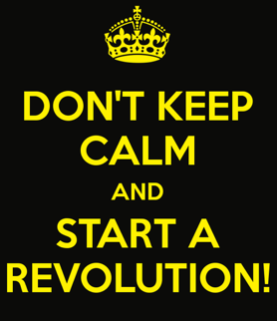 In fact, if you actually ponder, you would perceive that the real driver of this phenomenon has been something else entirely. It is the proliferation of ‘shared economy’ lifestyle that makes these social use cases so prominent and common for us. Also your payment instances and touch points intersect across the whole matrix of these use cases. Traditionally, the process has been pretty fragmented with the social & fun experience never coming across in those payments you made with your friends. Until now!
In fact, if you actually ponder, you would perceive that the real driver of this phenomenon has been something else entirely. It is the proliferation of ‘shared economy’ lifestyle that makes these social use cases so prominent and common for us. Also your payment instances and touch points intersect across the whole matrix of these use cases. Traditionally, the process has been pretty fragmented with the social & fun experience never coming across in those payments you made with your friends. Until now!
And the reasons are plentiful. Let’s start from why social commerce has not worked with the incumbents (your digital wallets) –
- The pain of uploading money first from your bank account (because come on, you don’t keep large amounts of money in your mobile wallet)
- The limits of sending money to another wallet (You can’t send more than Rs. 10k at one time as a normal user!)
- The charges and time delays on withdrawing my wallet balance into my bank account (They are charging you for transferring your money back to yourself!)
And I am sure you must have realized that the arrival of our own stack – UPI is the one of the key turn arounds (the ‘Paypal moment’) for Indian ecosystem, especially in terms of enabling ‘Social Payments’ as a category to exist independently in a big manner. UPI has brought about 10X the simplicity and 10X the speed which is a core pre-requisite for situations where you need to share money with your friends without any awkwardness. Now imagine adding all your social use cases on top of this beautiful and secure base of UPI. As you may have realized by now, that not only does it create a completely new paradigm but also increases the value by an order of magnitude (because of the network effects).
Once the wheels of motion start on any evolutionary path, it becomes almost impossible to stop them. The natural extension is that this category is bound to grow in India as well both in numbers and value (give the fact that it has already reached to 10s of billions of dollars in the west (US) with Venmo and the east (China) with WePay). The key thing to remember here is that in any new economy, it requires a fresh approach and outlook since the positioning is different from traditional P2P players and hence the product delivery and experience also needs to be different for the user. There have been numerous examples around the world with large social networks trying to add a basic P2P payments functionality and hoping it to take off in a big way. But it has not worked that well numerous examples like Snapcash (P2P payments via Snapchat in US).
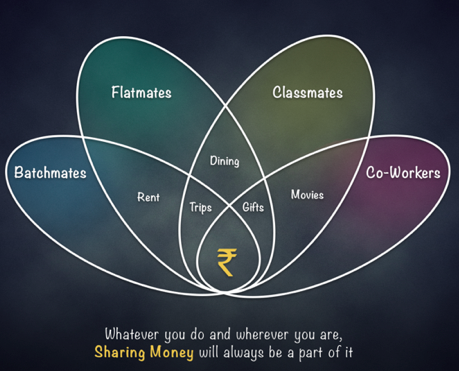 This brings us full circle to the two golden philosophies that have stood the test of time again and again –
This brings us full circle to the two golden philosophies that have stood the test of time again and again –
- The products that work on the premise of ‘this thing/activity can be done here too’ never make the cut. For example – ‘You can send money on Paypal too!’ is NOT what a Venmo user is thinking.
- Once a consumer associates a product with a certain repeat and high frequency use case, it becomes nearly impossible to change his habit and perception for that product. For example – Messenger has traditionally been a place for sending messages and that is what a user thinks of when he recalls that app (and not for sending money).
This is where the formidable advantage of having a clean slate comes in –
- Tailoring the product design around your real world habits when it comes to splitting, collecting, managing and tracking all your payments with your close contacts
- Ensuring that the experience is insanely fun so that it takes away all the awkwardness that traditionally accompanies any monetary transaction with your friends
- Ensuring that the product caters to all your use cases to such a minute detail that even you get surprised when it comes to the features!
Needless to say that I am more than excited about how the Indian market is evolving in the fin-tech domain (especially with the Indian government supporting it at an awesome level). Look forward to continued awesomeness and magic along the way.
Cheers, Rohit Taneja, Mypoolin
Creating a company brand — outside a product brand
One of the top two responsibilities of the CEO is to ensure that there is sufficient cash in the bank at all times. That often requires raising money from investors; an unpleasant task for most people! This article discusses a mindset change that is useful for fund raising.
The company by itself is a product that is best sold gradually and continuously to the investors — both public and private.
When we buy any product — say a mobile phone — we do so either because someone told us to or because our research led us to it. Even when we research a product, our view gets influenced by what we have heard about it. In the world of consumer goods, this is the power of the Brand. Raising money also relies a great deal on how the company is “perceived.” This perception is the company’s brand. The first round of money is largely driven by this brand perception. A lot of other aspects of the company (including fund raising in subsequent rounds) are affected by brand, as we will discuss in this article.
A company has two types of brands that coexist — the brand of the company and the brand of its product(s). Frequently the company’s brand gets forgotten or confused with that of the product. Yet, the company brand is omnipresent; created by the team, vision, past success, market opportunity, etc. For e.g. Nandan Nilekani’s next startup will have an immediate brand because of the team — well before the product has even been identified. As mentioned before, the first round is primarily driven by the company brand because there is nothing else.
The importance of company brand to fund raising often diminishes with time because delivered financial and operating metrics become the criterion for evaluating the company. When customers start using its product, the company’s brand gets pushed even further back because the overwhelming brand is that of its product. However this neglect is a wasted opportunity. In most companies there is no explicit recognition of the company’s brand and it has no identified owner. Given the criticality of the company brand for raising money, it’s imperative for the CEO to build that brand. CEOs who are very skilled at raising funds realize that they need to maintain the company brand in addition to the product brand. Consider for e.g. PayTM where Vijay has successfully navigated in and out of many businesses, while keeping the company brand associated with the promise of the future. Another example of the company brand being a driver is Theranos, the Palo Alto based Health Tech Company; of course the Theranos story did not end well because their brand was not backed by execution. However just that brand alone enabled Theranos to raise a fortune.
The Company Brand is not built in a day
Company brand building happens well in advance of fund raising and ideally never stops; the intensity just varies with time and circumstances. There are many ways to build the company brand in the early years of a company’s life.
- 1–1 engagement with investors to cultivate familiarity: set up periodic meetings with relevant investors to keep them updated, get their views, and build a relationship. These same people will talk about your company in forums and eventually people buy from people.
- PR — press appearances are noticed by investors (and by prospective employees, and customers). Its often hard to stay in the press for the right reasons so this has to be dealt with conservatively.
- Presence in forums — establish the position of a thought leader, be seen by peers in the correct context. These same peers will be used as references by future investors. So speak at events like the NASSCOM product forum or TIE.
- Key influencers in many areas; they can be cultivated as references or engaged as advisors
- Customer proxies — for e.g. head of HR of INFY if the product is to be sold to HR
- Product experts — for e.g. an advisor from Apple for a company that banks on usability
- Go-to-market experts — for e.g. someone from the sales team at Workday, for a SaaS company
A good company brand offers benefits that go beyond fund raising. It drives recruitment and retention (e.g. “best place to work”). It drives sales because customers often buy the company before they buy the product (e.g. the proverbial purchase from IBM). It drives policy/public acceptability (e.g. Google/Infosys wanting to be seen as doing good.)
Company brand building therefore needs to be owned explicitly — often by the CEO — and catered to as one of the critical outbound agenda items. By investing in the company brand from day one, the company’s odds of successful fund raising go up substantially.
Guest Post by Ashish Gupta, Helion Venture Capital
Capability -> Functionality -> Usability
The capability to build something – a product or a solution – is, but, just the start of things. Capability is needed to build a product but capability is not what gets your product to be loved by your (potential) customers.
One leverages capability to create a functionality (call it a feature, if you may). This functionality is created based on a broad understanding of the market needs e.g. one needs a mode of transport to go from one place to another. That is a broad market need. Based on this realisation, we set about building our solution. Depending on how one has understood the problem, the solution may result in producing a physical product like a new kind of cycle or a service, like a cab-hailing service.
 This can be called creating the functionality.
This can be called creating the functionality.
But this too is not enough. With functionality, one has expressed his/her understanding of the problem and to a great extent how one’s own perception has influenced the solution. When one goes a step further to get into the specifics of particular user needs (as compared with the broad market needs that I mentioned a bit earlier), then one starts to look at the usability or, as I prefer calling it, the usefulness of the solution.
To understand the user’s needs one needs a deep understanding of human behaviour itself. More specifically, one needs to observe and understand human behaviour in specific situations. So while one can build functionality based on a market need, to build usability, one needs to really observe and understand the user.
Being a keen observer, I notice multiple things and many times I find myself wondering at the thought that went behind creating that experience. An interesting example is this wash basin that I found at a major sports store.
Numerous times I have been a witness to a mis-aligned combination of tap, tap knob, wash basin and basin outlet. I am sure you too have. This one ranked among the top. The tap was actually hidden away. Did the person who put this thing together, have the capability? Yes! Did s/he understand the general market need? Yes! Did s/he really think about the user while building this? I would say, No? Or maybe, s/he did not care enough. But I am sure you get the point of usefulness.
In our own experience for the past 2 years, we have build multiple hi-tech features, cracking complex technical problems, patting ourselves on the back for being the geniuses that we are. But we realise that this is just a demonstration of our capability and what we can build from here is mere functionality until we get into the skin of the user. Of course, when I say user, each solution could have multiple, each with his/her own whims and fancies and hopefully a few common universal traits.
At RobusTest, on a daily basis, we try to bridge the gap between functionality and usability. Reminds me of something that I learnt in school about a variable tending toa value. In our case, on the number line between functionality and usability, we are striving towards usability – which is a constant goal but never completely reached.
The same should apply to any product/service and may well, be that small tweak that may get you that product/market fit that you seek.
Guest Post contributed by Aishwarya Mishra, Robustest
What’s the TAM Chasm?
How one entrepreneur’s mountain looks like a VC’s molehill
The apocryphal story of a newbie B2B founder, with deep domain knowledge, but no experience as an entrepreneur or in a startup. Note that while this example is not based on a single entrepreneur, it’s a composite to highlight the extremes.
Amita was a deep domain expert, with 15 years of experience in Wicro’s manufacturing services vertical. She identified a specific problem that a few of her customers had, costing them millions every year, which would get solved with a software product she dreamed about building. Being bitten by the entrepreneurial bug (her classmate founded FlipDeal), she decided to work together with a few old friends and colleagues, and start a business attacking the problem, with a couple of trusting old customers agreeing to do a paid pilot when she had the product ready.
As Amita and her team built the product, they initially used their own savings. Friends advised her to go to VCs, since this was exactly the kind of high-tech manufacturing software product that many VCs said they would fund. Amita was excited, she had seen FlipDeal raise a few Billion $, and felt that though her startup didn’t need as much, it would be good to raise a few million to hasten the pace.
The first VC meeting was a disaster, she was asked for their TAM (Total Addressable Market). And she was hardly able to define it well enough on the fly. The VC also said that manufacturing software was passe, IoT was the future.
“What’s my TAM?” she wondered on the ride back to the office.
“What’s our TAM?” the team asked her.
On the one hand, the specific problem they were solving was only for manufacturers in the auto ancillary business. This was a big sized market they thought, 60 odd large customers and a few hundred smaller ones spread over US, EU. The problem their product solved cost the large companies a few million dollars a year, and cost the smaller companies a hundred thousand dollars a year. Overall solving this problem would save the industry $300M. Of this, they estimated, they could charge $75M for the product.
The team was happy. There were few competitors and they felt they could become a good solid $25M business.
The next meeting with another VC was even worse than the first one.
“$75M TAM for an IoT product? For someone as experienced as you, and with the stellar team you’ve got, why are you taking so much risk — 8/10 startups fail you know — for such a small market?” advised the VC, running a $100M fund. “We will only fund you if you’re looking at a $1 billion market, and can make $100M annual revenue, otherwise the risk/reward doesn’t work out”.
Amita was baffled at how easily she and her team had been about to step into such a bad risk/reward tradeoff, even though they were smart, thorough professionals, who should have known better.
She decided to attack a much larger market, that was nearly the same as what they were trying to solve a problem for. Of course she didn’t know any customer in that area, but they were manufacturers too. Wouldn’t they have the same problems? No one in her team had done sales to the new segment, but how hard could it be to sell to a new vertical?
Back in the office, the team brainstormed the new market, $3 Billion wide, IoT for manufacturing across different verticals. Now the product roadmap had to change, since they needed to address different problems for different verticals, and they needed to make the product more generic. They had to drop some of the more intricate features for the auto-ancillary features too. That market was only a small drop in their overall bucket. So they obviously couldn’t do everything the small little market needed.
Miraculously the next VC agreed to fund Amita’s IoT product startup in a $3B market, and the team was now flush with cash, $2.5M to be exact. “Off to the races, let’s hire more people, build the product, get some more early customers” Amita thought.
But soon things weren’t rosy any more. Building the generic product that spanned multiple markets took much longer than expected.
Their early believers in the auto-ancillary turned sour, the product they were building was now not solving the specific point problem they had.
Their small initial pipeline ran dry, but they had a large pipeline of new prospects who they had never met before, who were all looking good to start engaging. But the sales cycles turned out to be much longer than expected outside of auto-ancillary. Perhaps the problem wasn’t as serious for others?
Their money was running out too, the $2.5M was designed to run for 18 months. Now at 12 months, staring at 6m of runway, with no product launched, no pilots won, and increasingly long sales cycles, Amita was at a loss.
Where had they gone wrong?
Wasn’t it supposed to be less risky to go after a large market?
Shouldn’t they get a great pipeline from the new sales guy they hired for a lot of $?
When their product built for a $75M TAM generated solid early paid pilots, why were they struggling to get any engagement in a $3B market?
Wasn’t it validation that they had a world class VC on board?
_________________
This is the story of some of the most capable founders with deep domain expertise, that I meet every month. While they have tons of deep experience, product ability, and network, it’s typically in a small specific domain, and not in a large, deep market.
In the process of building their startup, IF they move from small markets they know like the back of their palms, to large markets where they don’t know as much, the risk they are taking explodes.
On the other hand, if they are domain experts in the larger market, or end up creating a new large market, out of the small market they start in, then they have a great chance of building a true $1B+ business. Deep domain experts with 20+ yrs of expertise, selling and building for F500 — are best off hunting Whales, or Brontosaurus as Christoph Janz writes.
Typical VC fund economics
VCs with $100M funds need to return $300M to their investors. That’s the promise they make to their investors, 4X gross returns in 10 years as Fred Wilson shows, from a portfolio of top notch startups. And as Tomer Dean points out 95% of VCs fail to deliver sufficient returns to their investors!
So with 8/10 funded startups failing, a VC needs each startup in the portfolio to shoot for a $100M cash return to the fund. With a 20% ownership at exit, the startup must be worth $500M at exit, in 7–10 years from funding.
A startup seeking VC funds, therefore needs to rocket from $5M-$500M market cap in 10 years or less to be a success for a VC. To do this you have to build a $100M revenue business. This demands a market size well in excess of $1B.
At this return rate, the VC is ok if 90% of their startups fail the test, and fall short of returning $100M cash to the fund. That’s the risk/reward the VC is talking about.
At the other end, for a founder who has initial customers, has solved similar problems in the past, has a strong team, there’s actually little risk in making the first $1M revenue. Factor in a small market where no one else is solving the particular problem really well, they have little competition, and may win customers through referrals quickly. They have a good chance at building a $10M revenue startup, which might be valued at $40M.
Computing the risk/reward expected outcomes
In the VC model, going after a large market, the founders/employees end up owning 20% of the company at exit, with a 10% chance of getting there.
20% x $500M x 10% = $10M expected outcome.
In the bootstrapped model, going after a small market, the founders/employees own 80% at exit, with a 40% chance of getting there.
80% x $40M x 40% = $12.8M expected outcome.
Very similar expected outcomes, but very different risk profiles.
On the one hand, VC money is like strapping a nuclear fuel powered jet packon your back. When it works you get to orbit, but 8/10 times when you’re not ready for it, you’ll die.
On the other hand a longer slower more arduous climb up Mt. Everest, the rate of death is still high, but substantially more manageable risk wise.
Which path you choose as a founder, should depend on the size of the market you’re chasing, the cost of acquiring customers in that market, whether there are network effects that aid early movers, how much it will cost to build the product out to the quality the market demands, your own affordable loss, and more. And as Clement Vouillon says both paths are fine, but do know which path you’re on!
Too many founders are going to VCs with sub-scale markets (< $1B), and blaming them for not taking risks. A VC is NOT in the job of taking risks. They’re in job of building a high reward portfolio, and a small market can’t give a high enough reward.
Many founders think this is a one-time decision. Absolutely not! As Atlassian, Github and others have shown, it’s totally possible to bootstrap to find the right market-fit, and then take growth capital when you’re truly ready.
If you’re an early stage SaaS founder, and want to do this better, stay tuned for some hands-on assistance to grow past this choice.
Thanks to Manoj Menon for reading an early draft.




